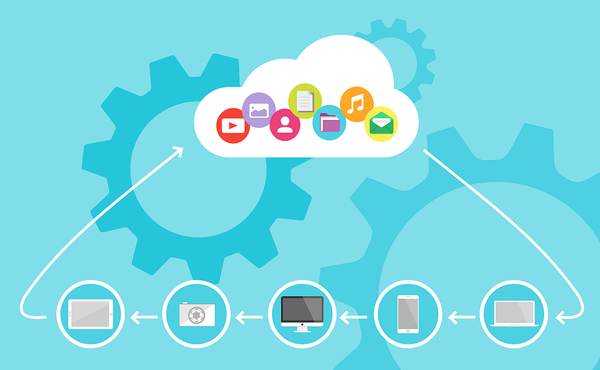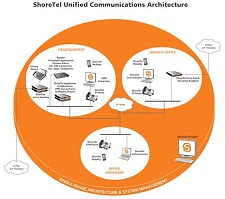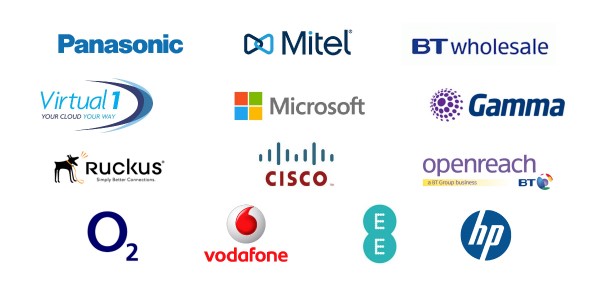The Incom Business Systems Blog Archives
7 steps for successful migration to Cloud Computing
01/03/19

Migrating to Cloud Computing offers many benefits to a business; reduced costs and increased flexibility, scalability and security. Many businesses are choosing to migrate, but there may be concerns about possible impact on the business.
Perhaps the number one concern voiced by business owners is the vulnerability of data and company information, removed from on-premises servers and placed out of their hands, in the Cloud. As reassurance, all good Cloud providers will have a resilient security infrastructure, to achieve accessibility with robust security.
Perhaps the second major concern, when it comes to migration, is the process itself. Depending on the size of the business or organisation, moving all applications and associated data to the Cloud can be a formidable task, and one that is not without risk. However, there are sensible steps you can take to plan and prepare for migration, which will help reduce the risk and the worry when the time comes.
Here are our top tips for a successful migration:
Step 1 - Analyse your existing infrastructure
Undertake a full audit of all of the applications, systems and processes that your existing infrastructure supports. Areas to consider, include:
- Number of end users
- Presence of sensitive data or information
- Current capacity
- Levels of access
- Remote / mobile access
- Existing hardware
- Security provision
Step 2 - Plan ahead for your business
Migrating to Cloud Computing offers an exciting opportunity to make improvements and streamline processes. Your virtual infrastructure will be configured to the needs of the business, so now is the time to think about making positive improvements.
Assess how your systems perform in the existing IT environment and try to identify any pain-points that could be addressed. Highlight any ‘clunky’ points in your work processes, or duplication of tasks: you can talk to your chosen provider about streamlining and integration.
Step 3 - Choose a cloud IT provider
There are five main points to consider when choosing the right cloud provider for your business:
#1 - Cost: weigh this up with the level of service they offer, to ensure they will meet your needs.
#2 - Communication: avoid providers that use jargon and choose a company that speaks in plain English and explains things clearly
#3 –-Technical capabilities: they must be able to support your business requirements and operate with easy to manage, user-friendly systems.
#4 - Support: what level of on-going support will they provide, and how will change requests be managed?
#5 - Security: what measures are in place to backup and protect your data, and what is their approach to disaster recovery?
Once you have chosen an appropriate provider, they will be able to guide you through the migration process and take steps to minimise disruption to your business.
Step 4 - Final stages of preparation
Make sure all staff members are aware of the planned migration period, and the timescale it will cover. Advise on any limitations to access during this time: any services or applications that may be unavoidably disrupted.
Your provider will advise on any steps you should take to protect the business throughout the migration process and work with you to ensure that it is ‘business as usual’ for your staff and customers.
Step 5 - Migration period
Your provider will help you to decide whether a full migration, or partial one (using a hybrid of virtual and on-premises servers), is best for the business. This will depend on the size of your organisation and the workload for migration.
If the organisation is a large one, there may be vast amounts of data to transfer, which can be time-consuming and result in ‘bottlenecks’. Data compression may be advised to overcome this.
Step 6 - Commence use
Once all, or some, of your applications have been migrated to the Cloud, you can start to use them via the virtual servers. This gives an opportunity to compare speed and performance against the notes you made in the initial planning stage.
Most, but not all, applications will run better through a virtual server. Any disruption or delay in use should be reported to your provider for them to trouble-shoot where possible.
Step 7 - Disconnect old infrastructure
All applications, connectivity and accessibility will be rigorously tested, until both you and your provider are satisfied that the new infrastructure meets expectations. Once this has been achieved, you will be able to permanently disconnect your old server.
All hardware can also be disconnected and removed from the premises - your infrastructure is off the ground and up in the Cloud!
To talk to us about our cloud IT services, and how we can support the migration process, please call
0161 788 0000.
|
 [0 Comments] Post a Comment [0 Comments] Post a Comment |
Part 3 - On premises vs. cloud computing - Security
31/01/19

Cloud platforms are designed to give your infrastructure a high level of resilience, with built in firewall and VPN (Virtual Private Network). The VPN is of particular importance for businesses that allow mobile or remote working, as it protects data accessed via a public network, such as the Internet.
Integrated backup services mean peace of mind when it comes to protecting information and data. Should a security breach or data loss occur, cloud platforms enable rapid disaster recovery, with business continuity as a priority.
Cloud computing therefore offers a robust and reliable way to build a business infrastructure, without the costs associated with additional security provision.
The benefits to a business of reduced cost, increased flexibility, scalability and security, make the virtues of cloud computing hard to ignore. Once your business has migrated to cloud computing you will be ready for growth, with an agile and future-proof infrastructure.
To learn more about the benefits of Cloud Computing in terms of cost savings, performance and peace of mind, read Part 1 and Part 2 of our On Premises vs. Cloud Computing blog series.
To find out more about cloud computing, or for help in assessing the IT needs of your business, please call 0161 788 0000.
|
 [0 Comments] Post a Comment [0 Comments] Post a Comment |
Part 2 - On premises vs. cloud computing - Speed & scalability
30/01/19

A cloud provider will help you to configure the service that you need: one that meets the current business requirements. As the business grows, your infrastructure will keep pace with greater demands, and capacity can be increased.
Most cloud computing services are provided on demand, offering flexibility and removing the need for capacity planning. Business can select additional computing resources with a few clicks of a mouse, which will then be available within minutes.
Cloud computing services are highly scalable, on a national or global level where necessary. Business can be assured that the right IT resources, such as bandwidth, storage and computing power, are available as needed, at any given location.
Learn more about the benefits of Cloud Computing in terms of security and peace of mind in Part 3: On Premise vs. Cloud Computing..
To find out more about cloud computing, or for help in assessing the IT needs of your business, please call 0161 788 0000.
|
 [0 Comments] Post a Comment [0 Comments] Post a Comment |
Part 1 - On premises vs. cloud computing – Cost savings
29/01/19

Cloud computing is a service based on virtual servers, from which normal business applications can be run. Virtual servers are an alternative to traditional on-premises or data centre servers, and offer the same storage, security and networking facilities.
Cloud computing is rapidly being adopted by organisations of all sizes, as part of the shift away from hardware, towards virtual services. In this three-part blog series, we will explore the key benefits to a business when considering migration to cloud computing.
Part 1 – Cost savings
The move away from traditional servers removes the need for a business to own and maintain expensive hardware and the associated costs of doing so. Cloud computing transforms the business infrastructure into a service, which is managed by the cloud provider. Users are able to manage their applications in the usual way, without concern for the provision of resources to support them.
Management of the business infrastructure includes set-up, monitoring and trouble-shooting, therefore avoiding the need for costly IT engineers. The tasks associated with on-premises servers, such as ‘racking & stacking’, software patching and hardware set-up, will no longer fall to the business IT team. This can free up their time to focus on core business issues.
Another significant cost benefit is that cloud computing services can be purchased on a pay for use basis, rather like we pay for traditional utilities such as gas and electricity. There are obvious advantages of this approach for a growing, changing business.
Learn more about the benefits of Cloud Computing in terms of performance and scalability in Part 2: On Premise vs. Cloud Computing.
To find out more about cloud computing, or for help in assessing the IT needs of your business, please call 0161 788 0000.
|
 [0 Comments] Post a Comment [0 Comments] Post a Comment |
Transforming your business with cloud-based contact centres
07/01/19

Businesses typically spend a large percentage of their marketing budget encouraging potential customers to call. What makes, or breaks, the success of these campaigns is the experience customers have when they make the decision to contact a company.
Callers who are kept waiting or are unsure if they have come through to the right place, are likely to hang up – and when they do, it’s highly unlikely that they will call back. Managing customer calls, especially during periods of high demand, can put a strain on resources, but it’s important to get it right.
More and more businesses are relieving this strain by employing the services of a contact centre. They offer the perfect solution for ensuring great customer experience and allow members of your business team to use their time more efficiently. Our cloud-based contact centres support businesses by providing flexible, professional services, tailored to the specific needs of your business.
Here are some of the many advantages of cloud-based contact centres:
- IVR (Interactive Voice Response) allows you to create specific scripts when customers give the reason for their call. They can then be diverted to the relevant information, with no queuing system needed.
- Priority response means that calls from your most important customers will never be missed.
- Advanced routing: the system will decipher the nature of the call and then divert to the appropriately skilled agent.
- Unified desktop enables call agent teams to work smarter and more collaboratively: they can see when other agents are busy, manage call back requests and pass on messages.
- Increased demand can easily be met by with additional resources. If callers are in a queue, they will be greeted and updated by auto attendant messages and will have your choice of music to listen to.
Multimedia handling
One of the challenges for businesses today, is that there are many different ways for customers to make contact: email, instant message, phone call, web chat and social media. Customer service teams need up to date information when accessing customer information and contact history.
Our cloud telephony systems handle all channels of communication in one place and offer instant access to customer information as a call comes in. This helps to build customer trust and confidence as the agent taking the call appears knowledgeable and professional.
Sales teams can also take advantage of the integrated CRM system; to access the most updated information when contacting customers.
Motivating agent teams
We know that you will get the best service for your business if call agents are highly trained and motivated. We supply our call centre departments with dynamic wallboards, which are highly visual and used for internal communications and information.
Agents have everything they need at their fingertips, to answer calls from your customers with confidence. This ensures a great experience for your customers and a great service from your call agents, which can only be good for your business.
Advanced performance reporting
As well as unifying communications, our cloud telephony systems enable real time reports to be created. By viewing up-to-the-minute statistical and geographical data, you can assess all call centre activity, as can the supervisors managing your agent team.
Our systems are ultimately flexible and scalable: additional resources can be added to respond to increased demand. Services are provided on a pay for use basis, rather like traditional utilities, such as gas and water. This enables your business to focus resources when and where they are most needed.
This efficient approach to handling customer contact will streamline processes and offer numerous cost savings, meaning a great ROI for your business.
To find out how our contact centres could benefit your business, or for details on any of our cloud-based services, please call
0161 788 0000
|
 [0 Comments] Post a Comment [0 Comments] Post a Comment |
Is your infrastructure future-proof?
29/11/18

The world of business is changing fast, as is the way we work. For a business to stay ahead of the competition, time should be spent thinking and planning for the future. Technologies are also developing fast, and businesses need to embrace them, or risk being left behind.
Here are some points to consider:
- New ways of working: Work is no longer confined to an office desk, 9-5. Nowadays, many people undertake work on the move, outside of routine hours, or away from the office. The terms agile, mobile, remote and homeworking have become part of our everyday vocabulary.
- Customer communication: Customers can contact a business via many different channels of communication: email, phone, instant message, web chat and social media. Businesses need to update customer information, regardless of how that customer gets in touch.
- Data Security: Tougher legislation has been introduced, governing how data is handled and stored. A breach in security could not only be damaging to reputation but could result in a hefty fine too.
- Changing needs:A business may enjoy a period of rapid growth (and subsequent increase in capacity demand) or could experience the need to scale-back or change direction. Lack of flexibility could hold the business back.
- Business Focus: Most business owners understand the need for their team to be focussed on growth and development. They may choose to outsource tasks that are beyond their area of expertise or would be a drain on resources if undertaken in-house.
Cloud computing and telephony are revolutionising the way businesses operate. They offer flexibility and the reassurance that your organisation is ready for the future. Here are 5 key ways that migrating to the cloud can address the above business needs:
#1 - Mobile working
Employees working away from the office will need a suitable device (laptop, tablet or smartphone). They may require connection to the company network, in order to access the information and data needed for the task at hand.
Mobile working can increase the security risk to a business, due to access of data through a public, unprotected network, such as the Internet. Cloud telephony systems protect the business from a potential data or security breach, with the use of a VPN (Virtual Private Network).
#2 - Keeping track of customer contact
Cloud telephony is a multimedia system, which unifies the communication channels your customers use to contact you. It can handle voice, data, video and instant messaging using a secure private network. It also offers CRM integration, so you can track all points of contact and enhance customer service.
When customers call a company, they will often make a decision based on their experience. If their call goes unanswered, they may decide to hang-up and are highly unlikely to call back.
Cloud telephony allows you to set-up auto attendant messages to greet and update your caller and choose appropriate music for them to listen to while they wait. These simple steps help to retain callers for longer, giving you the chance to take the call and gain a new customer.
#3 - Enhanced security
Both cloud telephony and computing systems offer more advanced security than traditional systems. The use of a VPN will protect the integrity of data used via mobile devices and lesson the likelihood of a security breach.
Cloud IT builds a sound security infrastructure, which makes cyber-crime far harder to commit. In fact, most cloud security breaches occur due to user error (inadequate or duplicate passwords for example), and not from being hacked!
Furthermore, data can be encrypted before it is sent or stored, and can only be accessed with the encryption key, which offers an additional layer of security.
#4 – Agility
Cloud-based solutions do not require the hardware needed for on-premises servers. Should the business headcount change, you can downsize or upscale your provision, without wasting money on unnecessary equipment, or needing to invest in additional hardware.
As the business needs change, services and capacity can be added or removed accordingly, and without delay. Changes to the configuration of the infrastructure are relatively easy to make, so there is no need to commit to requirements way ahead of time.
Cloud services are provided on a pay for use basis (so you need never pay for what you don’t use) but can respond quickly to increased demand.
#5 - Outsourced services
There are a number of key features that will allow staff members to use their skills on business-focussed tasks. Our cloud-based call centres can help your business by taking care of customer contact in a professional and efficient manner. Managing this in-house can put a strain on resources, particularly when call volumes are varied and unpredictable.
With cloud computing, we manage your business infrastructure, so no more need for expensive IT engineers, or in-house troubleshooting. This means your IT team are free to focus on core business improvements.
Cloud-based solutions are flexible and are configured to your current need and scale. They offer advanced security features and reduced costs.
If you would like to know more about how to future-proof your business or talk to us about any of our cloud-based services, please call 0161 788 4400.
|
 [0 Comments] Post a Comment [0 Comments] Post a Comment |
Part 2: Change how you communicate with your customers
07/11/18

There are many ways for businesses to communicate with customers, and customers to contact a business, including: email, instant messaging, on-line chat and social media. However, phone-calls are still an essential part of doing business, and the preferred method of communication for many customers with queries, orders to place or issues to resolve.
Businesses spend the vast majority of their marketing budget trying to get people to call them. It’s the number one CTA (Call to Action) for on-line and off-line promotion. With such a high investment made in persuading people to pick up the phone, why would any business risk offering a bad experience when they do?
Better for business
Taking care of customers when they contact your business will have a direct influence on your ability to convert and retain their custom. Significant improvements can also be made to business processes, which increase productivity by reducing wasted time.
Cloud Telephony can benefit your business in the following ways:
- Higher caller retention - leading to greater opportunities to engage with customers.
- Increased productivity - auto attendant messages mean callers can be diverted to the right department, by selecting the relevant option themselves. This reduces the time staff members spend processing calls, only having to respond to appropriately directed customers.
- Professional image - style of music, automatic messages and targeted responses will all help build an impression of the business being reliable, credible and professional.
- Product & service awareness - a waiting customer offers the perfect opportunity to raise awareness of services and products that may be of interest to them and can be tailored to specific product launches or service updates.
- Dispute resolution - call recording enables a business to review their customer experience: to demonstrate that they are up-to-speed with all communication and consistent in their response.
- Performance analytics - businesses can review call management, response times, length of calls, customer satisfaction and conversion rate, all of which help to address pain-points and build on strengths.
Good customer service is key in business, from the moment a customer decides to pick up the phone, and in every subsequent communication. Cloud Telephony offers many ways to enhance and monitor customer contact, so that calls can be well managed, and callers feel valued.
If you would like to know how we can help your business to communicate well with your customers, please call
0161 788 0000 or email
sales@incom.co.uk
Read Part 1: Find out how Cloud Telephony is changing the way we communicate with customers and delivering a better customer experience
|
 [0 Comments] Post a Comment [0 Comments] Post a Comment |
Part 1: Change how you communicate with your customers
05/11/18

The experience customers receive when contacting a business can create the right or wrong impression and build a picture of how the business values its customers. This experience will influence customers’ purchasing choices and ultimately whether or not they wish to become, or continue to be, your customer.
Taking care of callers
Incredibly, 70% of customers who call a business will be placed on hold and left listening to boring messages or, worse still, nothing at all. This immediately increases the chance of a customer hanging up, and if they do, 34% will never call back. They have been more or less driven into the arms of a competitor.
It is not always possible for a customer call to be answered immediately or go straight through to the individual or department they need to speak to. However, how the call is handled will influence their likelihood of holding on, their patience levels and the way they will engage with your business once they reach you.
What customers want
Cloud Telephony is changing the way we communicate with customers and delivering a better experience. Customers want to know that they are valued and that their time is respected. They want to be reassured that they have dialled the right number, that someone knows they are waiting and that their call will be answered, or appropriately directed, as soon as possible.
Some of the key customer benefits with Cloud Telephony are:
- Callers can be greeted with an automated message, to reassure them that they have dialled the correct number and are through to the business as a valued customer.
- Callers can listen to music, chosen for the business, which will hold their interest far longer than silence or a constant ringing tone. The style of music is appropriate to the identity of the company and helps to build the business brand.
- Auto attendant messages, or scripts, are used to reassure the caller while placed on hold or diverted to the appropriate department. Again, the voice used for these messages can be matched to the business identity.
- Calls can be seamlessly diverted to business mobile, as they operate as part of a unified communications system and are connected to the business telephony network.
- Calls can be recorded, which reassures customers regarding anything that has been discussed, agreed, or previously reported.
Good customer service is key in business, from the moment a customer decides to pick up the phone, and in every subsequent communication. Cloud Telephony offers many ways to enhance and monitor customer contact, so that calls can be well managed, and callers feel valued.
If you would like to know how we can help your business to communicate well with your customers, please call
0161 788 0000 or email
sales@incom.co.uk
Read Part 2: Find out how Cloud Telephony can make significant improvements to your business processes and increase productivity by reducing wasted time.
|
 [0 Comments] Post a Comment [0 Comments] Post a Comment |
Dispel the myths and concerns around Cloud Computing
10/10/18

Cloud Computing is transforming the way businesses communications structures are designed and built. However, number of high-profile security and data breaches, with the potential to damage a company’s reputation, have left customers feeling vulnerable.
The good news is Cloud Computing offers better accessibility for mobile workers, a more streamlined work process and the opportunity to integrate applications, increasing productivity and reducing costs.
Safety in numbers
Since the year 2009, the global uptake of cloud computing has risen exponentially, and shows no sign of slowing down. More and more businesses are migrating to a system that offers reduced costs, increased flexibility, scalability, and, yes - better security!
This means that large companies are making big investments in adopting and developing Cloud storage platforms. The more money invested, the greater the emphasis on protecting data: efforts to improve security even further will continue in line with the rise in demand.
Storing data safely
Whilst hacking is the more publicised risk with data storage, the reality is there should be greater concern over lost data, or data that cannot be accessed. If the system goes down, while the data may be safe in the long term, an inability to gain access could be detrimental to workflow and business continuity.
This is why it is so important to choose the right cloud provider for your business. Established providers will have a system for backing up your data in highly secure data centres and have a robust plan in place for disaster recovery. It is also wise to consider access to data via an alternative platform, such as Google Drive, to keep the business operating if a system outage occurs.
Encryption
Data can be encrypted before being sent or stored via a cloud computing system. This is done by using complex algorithms to lock and conceal data on the cloud. In order for a would-be hacker to access this data, they would need to crack the encryption key, which is no easy task.
Hacking into encrypted data would take a huge level of processing power, specialised software and a great deal of time. Again, the superior level of layered security, which cloud computing builds into your infrastructure, makes trying to break in a laborious and unattractive proposition for cyber criminals.
Conclusion
Cloud computing is the number one choice of infrastructure for the future. We hope this guide has helped to dispel any doubts about security and highlight ways that both businesses and providers can work to keep data safe and secure.
To find out more about our cloud services and security measures, please call 0161 788 0000.
|
 [0 Comments] Post a Comment [0 Comments] Post a Comment |
How safe is your data? Protect your data with Cloud Computing
05/10/18

Cloud computing is revolutionising the way businesses communication infrastructures are being designed and built.
However, many business owners have concerns around Cloud storage and security. Virtual servers allow Cloud IT providers to essentially run your infrastructure for you, and some businesses are uncomfortable with this perceived lack of control. This is even more the case if the business has its own on-premise server, with the ability to manage storage and backups in-house.
A number of high-profile security and data breaches, has further added to concerns, leaving customers and they reputations vulnerable. The good news is Cloud Computing is one of the safest ways to store data, here’s why:
It’s hard to hack the cloud
In comparison to traditional on-premises or data centre servers, it is relatively hard for hackers to break into a cloud-based infrastructure. Cloud-stored data is protected by a much more complex security system than locally stored data: it would require a very high level of technical expertise and a lot of time to break through.
Often, the reality behind reported cases of ‘hacking’ is that the weak link was actually individuals’ passwords, which present the opportunity for cyber criminals to calculate, or even guess, what they are.
Encryption
Data can be encrypted before being sent or stored via a Cloud Computing system. This is done by using complex algorithms to lock and conceal data on the Cloud. In order for a would-be hacker to access this data, they would need to crack the encryption key, which is no easy task.
Hacking into encrypted data would take a huge level of processing power, specialised software and a great deal of time. Again, the superior level of layered security, which cloud computing builds into your infrastructure, makes trying to break in a laborious and unattractive proposition for cyber criminals.
Conclusion
Cloud Computing is the number one choice of infrastructure for the future. Since the year 2009, the global uptake of cloud computing has risen exponentially, and shows no sign of slowing down.
To find out more about our cloud services and security measures, please call 0161 788 0000.
|
 [0 Comments] Post a Comment [0 Comments] Post a Comment |
Want to give your customers the perfect first impression?
28/06/18

Did you know that, on average, 94% of a company’s marketing budget is spent trying to get people to call their business? When they do call, a staggering 70% are transferred or placed on hold, faced with uninteresting recorded messages or worse still – silence or beeps!
Customers are the most important thing to your business; however, a poor on-hold experience can cost even the most professional businesses with the highest quality products and services both financially and in terms of their reputation.
A professionally voiced on hold and auto attendant message will allow you to build a better customer experience using customised scripts and music, which are used when your client is on hold or transferred. These scripts can vary in length and in their content and can be professionally recorded with a specific type of voice. Or, you can feature in the script yourself!
The music you choose alongside these scripts can reflect the nature of your company and industry, whether that is relaxed and calming or upbeat and motivational, the choice is yours.
How can professionally voiced on hold and auto attendant messages benefit your business?
- Keeping your customer’s attention – 34% of callers who hang up will never call back. Customers are far more likely to hang up when on hold if there is no message or music to keep them interested
- Improved efficiency and productivity – Thanks to the auto-attendant feature, callers can be directed to the right department by picking the correct option. This significantly reduces the amount of times your team are having to answer calls that are not related to their department, meaning less interruptions and increased productivity
- Increases product and service awareness – 20% of callers who hear an on-hold message make a purchasing decision based on the information they have heard. On hold messages provide the perfect opportunity to use your scripts to advertise other areas of your business that may suit specific customers, such as your website
- Enhancing your brand image and reputation – a professional audio message and music to suit your business will make your company sound more professional, ultimately leading to customers believing you’re a reliable business
- Nurturing customer relationships – updating your messages to suit special occasions or thanking your customers for their business and patience will build a personal connection between you and your clients – it’s all about caring for your customers
- Psychologically reduces your hold time – 90% of callers will hang up after 40 seconds if confronted with silence. The use of music and messages will provide a more pleasurable on hold experience, making time fly by!
With over three decades experience delivering multi award-winning communications solutions to our customers, our expert team can help you create a bespoke on hold and auto attendant solution which will help increase sales opportunities, enhance customer service and improve efficiency and productivity.
For more information, speak with our expert solutions team on
0800 054 2576 email
sales@incom.co.uk
|
 [0 Comments] Post a Comment [0 Comments] Post a Comment |
How To Assure Network and Service Quality
08/06/18

People are more connected than ever. We call, text, email, message, tweet and view streams of data across multiple communications channels every day. For telecoms providers, this increases the importance of maintaining robust service quality.
According to research from Teleco Professionals, 75% of telecoms service providers make network quality a key selling point, and yet, “50% of subscribers may churn this year because of it.”
When networks were smaller, maintaining service quality wasn't as challenging. These days, network providers need to work with multiple partners and suppliers, and are supporting the needs of many more customers, most of them using the infrastructure and systems to stream a heavier volume of data. Networks are investing more to ensure consumer and business needs are being met, now and into the future.
Assuring Service Quality
Telecoms network providers, partners and suppliers all have a role to play in ensuring network quality is maintained.
1. Forget about fault management
Managing service assurance is far more complex, more strategic than the traditional role played by the teams and partners/suppliers that fixed faults and responded to service issues. Traditionally, that was a reactive role. Now the work involved is proactive, with an emphasis on detecting issues before they become a problem and avoiding downtime at all costs.
2. Managing and sourcing an information flow
Detecting potential faults are more complex. Telecoms providers need to position themselves in the centre of a proactive information flow. Data needs to come in from multiple sources, from partner networks, complex value chains and thousands of other inputs, including monitoring systems for billions of pounds of hardware spread across the UK and worldwide.
3. Service and hardware inventory and repair records
One of the most effective ways to know what/when repairs are needed is to maintain digital records, in real-time, connected to an inventory of network hardware and systems. Integrating repair records with asset management systems gives those responsible for maintenance another way to check when upgrades are needed, which helps to ensure that downtime is kept to a minimum.
4. Service Level Agreements (SLAs) aligned with demand and business objectives
Maintaining network service quality need to align with two core objectives: The telecom provider’s aims and consumer demand patterns. Providing the two are aligned, performance targets and a program of continuous improvements should eliminate or reduce temporary problems that can cause network failures and customer dissatisfaction.
5. Proactive retention strategies
A certain percentage of customers will always churn - leave the network - but your provider shouldn’t be complacent. Every lost customer is lost revenue, and 50% will leave networks as a direct result of call/data quality. Solving problems quickly - ensuring issues are relayed from customers service staff - is one of the most effective ways to keep churn to a minimum.
Investing in next generation maintenance and service assurance systems is another way to avoid quality issues costing networks money. Customers need to see that their providers are proactively striving to improve their experience.
What does this mean to your business? Use the points above to benchmark providers when choosing business telephony solutions or if you’re thinking of switching providers. Downtime and poor service costs your business money, potentially negating the savings you may make with a cheaper provider. While cloud telephony will deliver costs savings to your business compared to existing legacy telecoms systems, service quality must override price as be a key factor in your decision.
Communications downtime either through human error or because of cyber-attack or disaster does happen; therefore, you’ll want to work with a business telecoms provider that will support your organisation in getting back to business as soon as possible. Ask about their business continuity plans and how they will support you.
Our expert team will guide you through the necessary considerations and help you assure network and service quality. Speak with us on 0800 054 2576 or email sales@incom.co.uk
Download Our Worksheet: Emergency Communications Plan worksheet
|
 [0 Comments] Post a Comment [0 Comments] Post a Comment |
Best Practices for Cloud Communications Migration
02/05/18
.jpg)
Businesses are more mobile and connected than ever. Migrating telephony and other communications to the Cloud are one of the most sensible ways modern companies can adapt to the changing needs and increasing demands of customers and team members.
However, it should be noted that similar to other business transformation activities, migrating to the Cloud should not be done without a clear strategy. Whilst Cloud Communications come with numerous benefits and savings; it can be an expensive process if those driving the project don't communicate a clear plan of action.
Businesses have a range of options, including Public or Private Cloud, and/or hybrid solutions. Some chose to keep some aspects of their system on-site, even if this is only a redundant backup PBX. There is also a range of infrastructure options, such as dedicated, hosted and virtualized.
Whatever systems and hosting solution you choose, there are a series of steps that need to be taken, based on industry best practise and our experience of migrating numerous companies.
Best Practice: Cloud Communications Action Plan
#1: Assemble your migration team
Small businesses should have at least one director responsible for the project. Whereas, in larger organisations, a team should be formed from different departments, e.g. customer services, operations, IT; to ensure the relevant parties are in constant contact during the project. This team should have senior management sponsorship and the right resources and permissions to drive the project forward.
So, this goes smoothly after implementation, ensure you take end-users views and feedback into consideration before commencing the project.
#2: Outline your objectives
Each business will have its own aims, but everyone we work with has one core aim: to ensure the migration is smooth and as seamless as possible. Keeping disruption to a minimum is important.
Within these aims, think about the other systems that need integrating with your principle telephony systems and staff mobile contracts. Aiming for a unified system, one that connects multiple communication channels is realistic and achievable for most budgets. It’s better to include these aims at this stage than ask for another integration during the process.
#3: Assess current contracts, hardware and licenses
Over the years, most companies accumulate a mishmash of communication channels and contracts. This can get confusing and expensive. Before going ahead, review where you stand with your contracts so that you know what has ended, what will end soon, and which have already expired. Share this information with the Cloud partner you select to manage your migration, telephony contracts and systems.
#4: Do a systems discovery
Not everything about a legacy communication system is how it appears. Review which channels and hardware rely on third-party solutions, then outline how/whether you can replace these with something more agile. Some of these may come with their own contracts, so check what has already expired or what will expire soon.
#5: Plan the roadmap
Working with your new business communications partner, plan the roadmap you need to get from where you are to your simplified, Unified Cloud-based goal. Thanks to the work you’ve already done and the team you assembled (stage 1), this step should be relatively painless, resulting in a clear roadmap and timeline that you can put into action.
After the systems have been migrated, test them. Make sure end-users and admin/managers can use them without difficulty and provide training as needed. Cloud providers will also help with this stage, as much or as little as you need. Once all of this is done, you can retire your legacy systems and in some cases, sell the PBX (Private Branch Exchange) and other pieces of hardware, potentially recouping some of the initial investment.
Cheat sheet: Migrating from ISDN to SIP – A Roadmap download.
|
 [0 Comments] Post a Comment [0 Comments] Post a Comment |
5 Ways Your Telephony Systems Are Costing Your Business
06/04/18

Fact: Legacy systems are costing you money, and these costs are only going to increase the longer it takes to switch over to more modern, unified and flexible communication systems.
Even when older systems still work, on-site PBX (private branch exchanges) are increasingly at risk from failing. Sourcing spare parts and engineers capable of fixing them will get more difficult, and expensive. Not investing now will cost more in the future.
If you’ve not switched over to high-speed fibre broadband or another up-to-date alternative, you soon won’t have a choice, with networks no longer supporting ISDN (Integrated Service Digital Network) after 2025. Customers and staff need to work with companies that support modern, faster communication channels; your businesses depend on this, now more than ever.
If this sounds like scaremongering, it’s not. Below are five ways your legacy telephony systems are costing your business.
Legacy Telephony Systems: Bottom Line and Intangible Costs
#1: Higher running costs
Compared with modern solutions, such as SIP - Session Initiation Protocol (SIP) - trunking, an Internet-based service that connects Voice over Internet Protocol (VoIP) customers to traditional phone networks, PBX systems are expensive. Similar to the cost of keeping servers on-site instead of the cloud, you have all of the hardware and maintenance to include in the budget.
#2: Reduced flexibility
Businesses that need to move, expand, or need another office/site, can scale more easily with cloud-based systems. The same is true if your headcount goes up or down. Unified Communications offer the kind of flexibility that is more expensive and time consuming with legacy technology.
#3: Missing out on savings
Telephony systems that aren't compatible with modern technology also have higher operating costs. New phone systems can take advantage of lower voice, video and data costs, which means you can save even more over the year.
#4: Vulnerable systems
Out-dated systems, with less sophisticated security, are more vulnerable to hackers and cyber criminals. We saw that with the WannaCrypt - ransomware - an attack that crippled the NHS earlier this year and the more recent Petya attack.
#5: Unable to cope with demand
Customers want quick responses, irrespective of the communication channel they use: phone, instant message, social media, email, or web chat. Front-line staff need access to CRM systems so that they can trace the contact history, which is normal in most medium to large companies. But these systems are only effective when the technology connecting staff to customers - and one another - is equally up-to-date; otherwise you end up with unhappy customers and frustrated staff.
Considering these costs, maintaining legacy systems can seem like a costly endeavour. Switching to modern, Unified Communications technology and services is smarter, better for customers and staff, and cheaper.
To find out more and discuss your requirements, contact our team. We would be delighted to talk you through the options and crunch the figures to see what savings your business could actually get.
Cheat sheet: Migrating from ISDN to SIP – A Roadmap download.
|
 [0 Comments] Post a Comment [0 Comments] Post a Comment |
5 Key Considerations – Choosing A SIP Trunk Provider
01/03/18

Selecting the right SIP Trunk provider
Only a few years ago, in 2012, organisations were starting to consider moving
business telephony and communication online through SIP providers. For many, early caution turned into action, with security one of the top consideration for companies moving telecoms online through SIP providers.
SIP - Session Initiation Protocol (SIP) - trunking is an Internet-based service that connects
Voice over Internet Protocol (VoIP) customers to traditional phone networks. Instead of limiting calls to voice only, SIP trunking makes Unified Communication possible, including video, web conferencing and screen sharing, all through a SIP-based private branch exchange (IP-PBX).
Compared to traditional landlines and legacy PBXs, businesses have more flexibility and none of the capital expenses and headaches. Software Advice conducted a survey into SIP adoption, finding that the majority of IT decision makers are happy with service quality, and more will consolidate Unified Communications in the cloud.
Here are a few things businesses need to consider when selecting a SIP provider.
SIP Providers: Key Considerations
#1: Security
For any company switching over to a SIP provider, or placing any of their business communications in the Cloud, security should always be the top priority. According to
a Software Advice survey, 23% of respondents assess a provider's security provisions before other considerations.
When weighing up different vendors, look out for the following phrases:
- TLS: Transport-Layer Security is a widely used (also referred to as SSL) cryptographic protocol that ensures the connection is private and safeguards message integrity. For extra security, IP-PBXs and SIPs should operate behind firewalls and if necessary, transmit safely from within a Virtual Private Network (VPN).
- STRP: Secure Real-Time Transport Protocol isn’t as commonplace, but this allows for live encryption of audio streams, for added security.
- Also, it might be worth looking out for providers with ISO certification and shares information about the cloud servers’ security. Companies that make data security a top priority should always work with providers that have the same mindset, which is more important than ever when cyber-threats are on the increase.
#2: Support
Support is comparable to security. Working with a provider that offers first-class support means you won’t be without a phone line for long if anything goes wrong. Knowing that you can be up and running quickly, even when you need disaster recovery support, is essential for peace of mind and business continuity planning.
#3: Communication
SIP providers are in the communication business. They exist to ensure you can call clients and colleagues and they can call you; or you can do a conference call, or do a quick screen share. But it doesn't help anyone if they speak in jargon and acronyms, making everything twice as confusing as necessary. Work with a SIP provider that speaks in plain English.
#4: Price
Implementing SIP trunking isn’t just about saving money and reducing costs. One of the many benefits of Unified Communication should include cost savings - since you shouldn’t need hardware and all of the associated costs - but there are other things to consider, beyond the budget.
Businesses can scale easier with cloud communications, they are better prepared for a disaster, and it’s easier to think strategically when your telecoms are no longer an internal headache. Costs can vary widely, depending on what you need and the value a SIP provider is creating. Always ask for
case studies and customer testimonials.
#5: Connectivity
Making a move to a SIP provider is easier when you have a strong, reliable, broadband connection. Have this conversation with a SIP provider early on and see if you need to make any changes to your
business broadband. before investigating further.
Moving over to SIP providers is proving a popular, smart, long-term choice for many businesses. Now more than ever security is a key consideration, with cost and support high on the list. When you talk to SIP providers, make sure you are going to work with one that takes the time to understand your business, since that will help ensure the project is delivered successfully.
Contact our team if you would like to talk to an expert about your business telecommunications. We are happy to chat through your requirements and explore the options with you. Speak with our team
0800 054 2576
Whitepaper: The Ultimate Guide For Moving From ISDN To SIP download
|
 [0 Comments] Post a Comment [0 Comments] Post a Comment |
Moving Premises? Considered Your Business Communications?
12/02/18
.jpg)
Moving into new premises is an exciting time for any company but there is a lot to consider. How much will it cost? How should you design your new office space? Who needs to know you are moving? Where do you start?!
If you are responsible for organising an office move, it can be a stressful time. Insufficient project management can result in delays, business disruption and unnecessary expense but, with careful planning, it is possible to deliver a seamless relocation.
Download our checklist below and learn how you can avoid costly mistakes and accomplish one of the most important aspects of any business move – retaining communication with your customers.
Checklist Download: Moving Your Business Communications
Planning a move? Bring in the experts
This checklist is a starting point for moving your business communications. With over three decades of experience supplying and installing award-winning solutions for our customers, the Incom-CNS team can guide you through the necessary considerations and help you to deliver a seamless move of premises for your business.
Call our team on 0161 788 0000 or email sales@incom.co.uk for more information.
|
 [0 Comments] Post a Comment [0 Comments] Post a Comment |
Do Your Business Continuity Plans Cover Telecoms?
15/01/18
No one expects disaster to strike. Business owners and managers have multiple worries, but how often does fire, theft, flood damage, power failures, catastrophic hardware/software failures and even terrorism, cross our minds?
Most of us worry about cashflow issues. Not closing enough deals. Coping with demand. Looking after customers. Managing staff, and other daily challenges. Next, we worry about long-term objectives and active projects. But whether we are prepared for an unexpected disaster: that worry doesn't often make it onto an actionable to-do list.
Not Enough Companies Have Business Continuity Plans In Place.
And yet, according to industry research, 20% of companies will, at some point, suffer a serious disaster. The majority - 80% - will fail within 13 months and from those that survive, 53% won’t recoup the losses they incurred as a result of the disaster.
Every moment your phones, email and other communication channels are down; you are losing money. Can you afford not to have a continuity plan that covers telecoms?
What A Business Continuity Plan Should Include
Every business continuity plan is unique to each business. Operational considerations for a retailer are different from the needs of an insurance provider, or solicitors. Larger firms need more complex plans, but this also means they should have the resources to setup somewhere else temporarily in the event of an extreme emergency, such as a fire.
However, even with operational differences that vary from company to company, communication is key for continuity planning. Here are a few of the essentials that every plan should include.
#1: Disaster Roles
In most cases, not everyone will be able to do the same work in the event of a disaster. Depending on the severity, plan each staff members role should a disaster strike - with a view to ensuring everyone is either working to manage external communications or focusing on getting the business operational again.
#2: Data Backup
Make sure your data, from customer records to accounts and orders, is secure. Businesses that lose data face a significant risk of failing. Cloud-based backup, with at least one redundancy, is the only sensible precaution to take. On-site data is highly risky since that is where disaster could easily strike.
#3: Review Assets
In the event of a fire, flood, theft or another disaster that causes serious damage to your premises, review the assets you have - that are undamaged - and useable again. Report all damages to your insurance company as soon as you can.
Rescue what you can to reduce the cost of getting set up again, and see what staff can use (if computers are damaged) instead. All of which is easier if files are stored in the cloud and easily accessible.
#4: Re-establish External Communications
Cloud communications ensure this can be done without one day's downtime. Landline numbers can divert to mobile phones or other landlines, and you can use email and social media to alert customers and potential customers of any disruption.
Getting back in contact with your customers is the quickest way to reassure them that everything is getting back to normal - even if it could involve a few days or weeks of disruption - and services are as uninterrupted as possible. It is also reassuring for staff to focus on problems they can fix unless they are involved with helping get the company operational again.
Like email and social media, telecoms are such a normal part of business operations that it can be easy to overlook these essentials. Even if you think a disaster is unlikely, you can’t take the risk of not being prepared. Businesses that are ready to handle a disaster, with a focus on business continuity, have a greater chance of surviving one - especially if your data is backed up and communications can be quickly reestablished with customers, suppliers and sales prospects.
Worksheet: Emergency Communications Plan worksheet
|
 [0 Comments] Post a Comment [0 Comments] Post a Comment |
5 Mobile Device Risks & How To Protect Your Organisation
12/12/17

On the whole, technology is a source of enormous gains for organisations across the world. Businesses, public sector and charities are all benefiting from the digital technology revolution we are going through, with productivity increases and cost savings some of the main advantages.
In time, if past revolutions are any indications, organisations will experience gains we can barely imagine. However, there are several downsides to technology.
Security weaknesses are one of the main challenges. As wonderful as it is that we can communicate more easily and quickly than ever before; criminals have readily exploited this same advantage for decades.
Our smartphones and tablets pose one of the greatest security risks to organisations. Staff and business leaders want to use them for work, but the bring your own device (BYOD) movement comes at a cost: Organisations are at greater risk from security breaches, data breaches and cyber threats.
5 Mobile Risks & How To Counter Them
1. Data breaches and leaks
Without a doubt, mobiles and tablets are the weakest links in any organisations data chain. They don't stay in the office, which means they're outside continuous security networks and vulnerable on home broadband and public Wi-Fi. Other systems and apps, including viruses, could be present, further increasing the risk factor.
It is the organisation's responsibility to provide training, policies - and, if needed - systems that protect personal devices to safeguard the organisation. One important way, to prevent data breaches - even more important after the implementation of the European General Data Protection Regulations (GDPR) in May 2018 - is to password protect and encrypt sensitive documents, to prevent unexpected data breaches and leaks.
2. Vulnerable to attack
According to a HP study, 97% of employee devices contain privacy issues and 75% don't have any encryption, which means your data is vulnerable.
A smart way to prevent viruses spreading is to place a gatekeeper whenever an employee wants to access a device from home or off-site. Gaining access to company systems, including email, social networks, files, CRMs and other software should require logging in via a secure virtual private network (VPN), or other encrypted gateways.
3. Mixing personal and organisation data on the same device
One of the main BYOD nightmares is the mixing of personal and sensitive information - including passwords - on the same device. Especially when the user is in a senior role or position of trust. Malware, ransomware and other viruses could easily find their way into secure networks through this channel.
There are numerous ways to prevent these issues. Issuing anti-virus software, passcode management software (for organisation accounts on personal devices - including email) and Enterprise Mobility Management (EMM) software so you can more effectively monitor and detect risks.
4. Stolen devices
Smartphones are attractive targets for criminals, and so easy to take. Too many people carry them around or place them somewhere easily accessible to criminals. Since criminals are getting smarter - with software able to crack passwords available on the dark web - you might want to invest in remote wiping and control capabilities, to avoid any data breaches as a result of loss or theft.
5. Data compliance
With GDPR coming into force in under one year, now is the time to ensure your network is secure enough for employees to use their own devices without senior managers constantly worrying that one smartphone could cost the organisation 4% of annual revenue - or €20 million - whichever is higher.
Worrying about this won’t solve the problem. Take action now, to ensure your staff can still use their own devices without them putting everything at risk from cyber-attacks and hackers.
Worksheet: Emergency Communications Plan worksheet
|
 [0 Comments] Post a Comment [0 Comments] Post a Comment |
8 Key Benefits Of Migrating To Cloud Telephony
14/11/17
.png)
Key Benefits Of Migrating Telephony And Communications To The Cloud
Cloud computing, software and storage is the way forward. We believe that businesses wanting to upgrade their communications would benefit from considering migrating to the cloud, instead of clinging to outdated on-premises hardware.
On average, most PBX systems (private branch exchange) only last for 8.5 years, which means companies with on-premises hardware have an opportunity to move away from legacy technology for a fraction of the cost, when their current systems need upgrading.
If you’re responsible for your business telephony systems, this post will provide you with some compelling reasons to migrate to cloud telephony. Read on…
Over the years, most small and medium enterprises will have accumulated a mishmash of communication tools and technology. Landlines, managed from a PBX. Smartphones. Email, sometimes connected to a CRM. SMS. Video and audio conferencing facilities, and new social media channels and cloud-based messaging systems and apps. It can get confusing, not to mention, expensive.
Benefits of Cloud Telephony Migration
#1: Unify & Simplify
Instead of managing multiple systems and phones, you can have one system manage everything - without worrying about the expenses and maintenance of hardware since everything within a contract is managed and maintained by the communication provider. Your IT team won’t need to worry about the PBX anymore.
Financially, instead of managing multiple contracts, everything - as far as possible (some third-party contracts may be outside the scope of a unified plan) - will come out in one monthly payment. Making admin less of a headache.
#2: Modern Features
Legacy PBX systems make it difficult, if not impossible, to access modern communication channels. Not only does this put your business at a disadvantage, often forcing companies to accumulate a mishmash of overlapping systems, but it is harder to work together as a team, collaborate and communicate effectively with customers.
Cloud communications eliminate these issues, without the expense of an upfront capital investment.
#3: Scalable and Flexible
Scaling up or down, according to demand and the ebb and flow of staff in a business, isn’t easy with PBX systems. However, with a hosted communications package, you can easily increase or decrease headcount as needed. Businesses can concentrate on commercial objectives instead of worrying about the technology that keeps everything operational.
#4: Mobility
Smartphones are an essential feature of modern business communications. Apps and the ability to take calls - on a work phone (so staff don't need to give out personal numbers) - anywhere are integral to how the majority of people work.
Modern professionals and knowledge economy workers need the flexibility a mobile provides, which for the sake of ensuring communications are unified, should be connected with on-site systems, storage and recording facilities.
#5: Affordable
Hosted unified cloud solutions are available at a range of price points, affordable for smaller businesses and comprehensive enough to manage the needs of large enterprises, including those that rely more than most on communications, such as call centres. Cloud telephony packages can include landline and mobile contracts, hardware, maintenance and software, depending on the needs of your business and budgetary constraints.
#6: Built-in Business Continuity
Disaster can strike at any time. With operational services in the cloud, you are prepared and ready with immediate built-in business continuity. Cloud systems aren’t affected by localised problems, including power cuts and natural disasters - and even if something happens near one data centre, there are redundancies and backup power generators, making your communication systems disaster proof.
#7: Integration
Most Unified Communications solutions can integrate with other business communication apps and third-party services, such as customer relationship management (CRM) solutions. This makes it easier to ensure your team provide a personalised service when customers or clients call.
#8: Increase Productivity
With Unified Communications, your team will reap the benefits of better collaboration and a more joined up communications system. This has a positive impact on overall productivity, particularly for businesses that want to enable more remote working. Many studies show that remote working boosts productivity, but only when business communications are optimised to support those employees.
Everything your telephony partner provides should drive continuous improvements and help your team achieve higher levels of productivity, without the expense and headaches that legacy systems cause. Migrating telephony and communications to the cloud makes it easier for managers and staff to focus on their jobs and goals, with the most efficient integrated cloud communication system operating at the touch of a button.
If you would like to find out more, get in touch with our team. Call 0800 054 2576 or contact us here.
Download our Emergency Communications Plan worksheet to align your business continuity planning with your business telecoms.
Worksheet: Emergency Communications Plan worksheet
|
 [0 Comments] Post a Comment [0 Comments] Post a Comment |
7 Steps To Ensure A Successful Migration To Cloud Communications
31/10/17

Migrating mission-critical services to the cloud are an increasingly popular choice amongst UK businesses. According to the Cloud Industry Forum (CIF), cloud adoption rates are at 88%, with 67% of companies set to accelerate cloud migration in 2017.
Communications are also slowly shifting into the cloud, with large and small businesses keen to reduce costs, remove barriers and improve productivity with a Unified Communications (UC) strategy.
Businesses are starting to see the value in unified, cloud-based communication. Right now, organisations often have too much choice, leading to confusing, costly and overlapping communication channels: Landline, mobile, email, online messaging, and Voice over Internet Protocol services (VoIP), social media and numerous others. Migrating to the cloud simplifies, unites overlapping services, and generates positive time efficiencies and cost savings.
Undertaking a successful cloud migration means designing and implementing a plan. Here we share seven important steps you need to put in place to ensure a UC strategy launches successfully:
#1: Determine Your Goals
Before you migrate anything to the cloud, you need to decide what you want to achieve. Saving money, time and improving processes are useful general guiding principles, but you need to work towards specific goals to ensure a migration generates positive results.
Designing a UC strategy starts with an assessment of your current communication technologies and platforms, with a focus on why they're inefficient and need improvements.
#2: Assess Current Situation
Conduct an audit on your current communication infrastructure:
- Make a list of the number of platforms and technologies used for internal and external communications.
- Determine if they are self-hosted or already in the cloud.
- Assess volume of communication through each channel.
- Assess the cost impact over the year, including any downtime and support contract costs.
- What are the costs of continuing to run your own physical servers, including property, security and backup support.
- Evaluate current security systems and costs, and whether they are adequate to protect your communication infrastructure from modern threats.
#3: Design Objectives & Aims
Now you have an idea what your communication infrastructure currently looks like; you can create an outline of what you want to achieve.
Do you want to simplify channels? Improve security? Reduce the risk of downtime and get more value for money from your support provider?
Design SMART objectives, working with the relevant internal stakeholders. Have a game plan before engaging any external provider, or shortlist of potential providers.
#4: Select the Right Partner
Moving voice, collaboration and communication channels to the cloud is not easy, especially when you have overlapping technologies and platforms. You need to the right partner to plan, migrate and provide on-going support.
Telecommunications partners with a strong reputation, known for delivering migration projects for small, medium and enterprise clients are ideal. Especially when they have extensive experience delivering best-of-breed solutions across a wide variety of complex environments, including when communications are hybrid - mixing on-premises, public and private.
Ensure you are working with a company that can provide examples of migrating communications from something resembling your current situation to one reflecting your goals.
#5: Select the Cloud Environment - Public, Private or Hybrid
We could write a lot about 'public', 'private' and 'hybrid' cloud environments, but we want to keep things simple.
Public clouds are where your services/channels -
telephony, collaboration, customer services - are operating in public data centres, with thousands of other companies. Amazon, Google and Microsoft are some of the biggest names in this space, alongside dozens of others.
Private clouds are servers you own and control. This involves extensive and costly hardware investments, which is why more companies are moving away from self-owned systems.
Hybrid - a mix of public and private servers - is proving the most popular option, with 71% of companies preferring a hybrid solution, to reduce costs, whilst retaining some control over the most sensitive aspects of their communication channels, according to
RightScale's State of the Cloud report.
#6: Plan the Migration
Once you have a clear idea what is being migrated, where it is going and what technology is being deployed, you can plan the migration, working with your telecoms partner.
Most companies start with a test migration. Keeping it small and simple. Internal communications and collaboration tools are a good starting point. Have a plan for this aspect of the migration, and then using this test data, design a more detailed plan that should include the following:
- Migration order of priorities.
- What a successful migration looks like, including milestones, timescales and metrics.
- Who is responsible for what (internal teams, managers, external providers, etc.).
- What training and new processes should come into play before, during, and after the migration.
- Backup everything - before and after the migration. Ensure part of this migration includes an active emergency backup plan and facilities.
#7: Migrate, Tweak and Monitor
Migrating everything to the cloud could take weeks or months, depending on the complexity of your communication needs and channels, and how easily your organisation can untangle legacy systems. Backup everything before starting the migration. Staff may also need to get used to new technology and processes, so have training plans in place.
Once everything is successfully migrated to the new environment(s), keep testing and tweaking until your communication channels are operating smoothly. Test and monitor carefully for a while after, before you officially sign-off on a successful migration.
Whitepaper: The Ultimate Guide For Moving From ISDN To SIP download
|
 [0 Comments] Post a Comment [0 Comments] Post a Comment |
Driving Productivity And Innovation With Unified Communications
23/10/17

There has been a lot of noise in recent years around ‘Unified Communications’. Digital technology is making new ways of working, collaborating and sharing far easier, compared to traditional landlines and legacy systems, and this is naturally being embraced by businesses and organisations.
This technology is not just for the big boys either. Small and medium businesses can reap the benefits of digital transformation, with low entry costs and flexible contracts. If you’re just beginning to explore how to make your business telecoms more agile, responsive and dynamic, read on…
Unified Communications use next generation technology, bringing voice, video, instant messaging, email, even CRM data, together in one solution to improve how team members communicate and manage customer relations. Legacy systems cost companies money, are harder to maintain and restrict collaboration opportunities, which reduces productivity.
Top 5 Productivity Gains From Unified Communications
1. More efficient remote working
Remote working is more popular than ever, with 62% of employees keen to work from home at least once a week, according to Randstad research. With Unified Communication, remote working - and times when staff are off-site (e.g. a client or sales meeting) - is more effective, making it seem as though those team members are still in the building.
2. Higher productivity
With more than one way to reach colleagues, you can stop wasting time chasing people when something is urgent and ensure deadlines are hit without as much stress.
3. Reduced overheads
Productivity always benefits when costs go down. Money can go into other things, such as training, marketing, customer service and sales. When companies invest in Unified Communications, they don't need to spend capital funds on hardware or worry about maintenance and other associated IT costs. Everything is managed by your business communications partner for a single monthly fee.
4. Faster customer response time
Multiple channels make it easier for customers to get quicker responses without getting passed between teams and departments. Unified Communications that link to a CRM (customer relationship management) system gives everyone the same view of message and contact history, making this an ideal solution for contact centres and those in customer-facing roles.
5. Improved collaboration opportunities
Staff can communicate more naturally - similar to how they communicate outside of work. Numerous studies have found that ad-hoc, unexpected meetings and conversations are responsible for innovation. Customers benefit from this, since new solutions are discovered, resulting in new products and services that improve customer relations and satisfaction.
Everyone benefits when communications are quicker, more efficient and instinctive. Costs go down. Productivity increases. Customers are happier with response times and staff having the relevant knowledge to answer their queries, no matter who answers the phone, message or email.
If you would like to find out more, get in touch with our team. Call 0800 054 2576 or contact us here.
Cheat sheet: Migrating from ISDN to SIP – A Roadmap download.
|
 [0 Comments] Post a Comment [0 Comments] Post a Comment |
On Premises vs. Cloud: Telecoms for Businesses
11/10/17

As invaluable as we find email, there is nothing as simple as picking up the phone and calling a client or supplier.
Customers feel better too, knowing they can call and place an order, or get an update on a project. Despite dozens of new ways to connect and contact one another, phones are still an essential part of doing business. AlI-powered Facebook Messenger bots will never replace telephony-based customer service.
However, there are aspects of business communications that are going through a much-needed overhaul. Legacy telephony infrastructure can't keep up with modern needs and evolving working patterns and trends. Gartner estimates that "Cloud telephony spending is expected to surpass on-premise telephony during 2017 [and they are] . . . projected to rise to $13.25 billion in 2019."
Benefits of Cloud Telephony
On-site PBX (private branch exchange) are increasingly at risk of failing. Downtime costs money. Businesses can't afford for phones to go down, especially when potential customers want to pick up the phone and place an order or resolve an issue. It damages reputations and impacts the bottom line.
PBX systems aren't easy to repair, especially when spare parts are in short supply. They can't always meet the needs of remote workers who still need a direction connection to the office telephony network. Adding and removing users isn't always easy either, especially when your business needs multiple PBX units hosted across several sites, all connected to the same primary landline number.
In comparison, cloud telephony doesn't involve further capital expenses for the business. Hosting, updates, management and security are all in the hands of the cloud telephony provider. Support is provided 24/7; with data centres keen to ensure up time is as close to 100% as possible. Security is paramount, with numerous physical and cyber measures in place to prevent hacking and cyber-attacks threatening your business and consumer data.
Compared to on-premises telephony, you can scale up and down as needed - depending on your permanent and flexible headcount - with telephony partners easily able to add new users. Costs scale up and down as needed too, so you don't need to worry about paying for more than you need. Disaster recovery is built into the systems cloud providers design so that your business is prepared and able to move quickly if the unexpected should happen.
Cloud-based telephony systems come with numerous other benefits, from professional hold music to call recording and performance analytics. These are some of the many reasons cloud solutions are proving so popular across multiple sectors. Businesses everywhere are more effective when they move systems to the cloud, increasing efficiencies and reducing fixed overheads and the burdens of operating legacy technology.
Moreover, and a key reason that many businesses have already migrated to cloud solutions, is call costs. Typically, these are lower than legacy systems both for national calls and international calls, and calls to mobiles.
There are also many benefits for businesses with remote workers or staff that spend time offsite. Their mobiles can integrate into the office phone systems, ensuring they secure access to company systems and data.
If you would like to find out more, get in touch with our team. Call 0800 054 2576 or contact us here.
Cheat sheet: Migrating from ISDN to SIP – A Roadmap download.
|
 [0 Comments] Post a Comment [0 Comments] Post a Comment |
Could Your Business Save Money With SIP Trunks?
04/10/17

'Digital Transformation' is a phrase that has been knocking about for several years now. Dressed up and surrounded by high-priced consultants, 'digital transformation' can appear confusing and inaccessible to many small and medium businesses.
But in reality, the majority of smaller companies are already going through a digital transformation. Shifting phone lines from analogue to digital (cloud telephony) is part of that, which is what SIP trunking is all about.
What Does SIP Trunking Actually Mean?
SIP - Session Initiation Protocol (SIP) - trunking is an Internet-based service that connects Voice over Internet Protocol (VoIP) customers to traditional phone networks. SIP trunking makes Unified Communication possible, including video, web conferencing and screen sharing, all through a SIP-based private branch exchange (IP-PBX). So instead of landline calls going to and from an internal PBX, calls travel through the Internet.
But there’s more to it than just making phone calls. With SIP trunks, you can do a lot more - voice, video, conferencing - and don't need to worry about the expense of hardware, maintenance and the limitations of analogue systems.
Can SIP Trunks Save Us Money?
Absolutely. Calls through SIP trunks (across the Internet) are cheaper than calls made through traditional landlines (ISDN). Not only are UK landline calls cheaper, but often so are mobile and international calls.
However, you do have to factor in call quality, the user experience - for staff and customers/clients - since you don't want cheap calls that sound like customers are connecting to an ancient modem. Calls should sound the same, if not better, than through traditional landlines. At the same time, you need to expect high levels of customer service and support, so that you can have phones up and running again quickly if anything goes wrong.
Installing a SIP private branch exchange (IP-PBX) is far more cost effective than traditional PBXs. No hardware. No maintenance to worry about. Instead, these cost savings can go into a system that can scale up and down as needed, with the service provider managing the software, updates and maintenance.
Another advantage of any digital transformation project is the cost savings compared to analogue and legacy systems.
Companies that have moved over to SIP providers are happy with the decision, according to Software Advice research, with 73% of IT decision makers surveyed saying they were "'very' or 'extremely satisfied' with the audio quality of calls connected by their SIP providers."
Furthermore, with no PBX platform to power and cool in your server room there are environmental benefits too. Using cloud telephony can reduce your carbon emissions by up to 45%, helping your business to achieve its sustainability targets.
High call quality, lower costs, energy savings and no need to worry about maintenance and hardware. Can you think of a good reason not to switch over to a SIP provider?
Whitepaper: The Ultimate Guide For Moving From ISDN To SIP download
|
 [0 Comments] Post a Comment [0 Comments] Post a Comment |
Is It All Over For ISDN?
26/09/17
In a word, yes!
Without ISDN (Integrated Service Digital Network), the Internet revolution would not have happened as quickly. ISDN replaced slower, dial-up broadband solutions, setting the standard for data and voice communications in the 1990s. At the time, ISDN was revolutionary. But everything has its day.
Technology has taken leaps forward since ISDN was created, with the largest British communications company, BT, set to phase ISDN out by 2025. In 2016, when the competition and markets authority (CMA) cleared the takeover of EE, BT Group had 31% of the broadband market (consumers and businesses), 37.6% of the home phone market and 33.8% of the mobile market. Even after Ofcom forced BT Openreach - the network division - to split from the Group, BT will continue to exert a large influence on the communications market and the services consumers and companies can access in the UK.
Telecoms is a competitive market. Each provider - whether they offer landlines, mobiles, VoIP or unified cloud-based communications - is investing heavily in speed and security to gain market share. Hence the move, in 2015, to phase out ISDN across the BT network within ten years.
In 2020, companies won't be able to buy new ISDN circuits and services, and then, five years later, this legacy network will shut down completely. If other networks haven't followed suit, they soon will. And those that run off BT networks (or former BT wires - after the switch to Openreach) will have no choice.
Either way, ISDN is a legacy technology that can no longer keep up with modern demand.
So, what are the new options?
High-speed fibre optic broadband and cloud-based Voice over Internet Protocol (VoIP) is the future, one that many businesses are already embracing. Instead of legacy private branch exchanges (PBXs) taking up space in your office, companies are moving everything to the cloud; with Unified Communications, the way forward.
Telephony and communications are fast becoming digital.
SIP trunking - Session Initiation Protocol - is another cloud-based solution that businesses are embracing, replacing the need for hardware PBX systems. Instead, VoIP services connect phones to networks, improving voice quality, whilst making it easier for companies to communicate through video, web conferencing and screen sharing.
ISDN can’t handle modern communication needs. Internet-based communications are already overtaking analogue solutions. Now's the time to make sure your business is equipped for a digital future.
br>
To get started download our guide to migrating from ISDN to SIP – just click on the link below.
Whitepaper: The Ultimate Guide For Moving From ISDN To SIP download
|
 [0 Comments] Post a Comment [0 Comments] Post a Comment |
The contact centre as touchpoint for service excellence
16/05/16

In our latest guest blog, Niki Waters, Projects Manager at Premier Holidays, identifies the trends and challenges shaping the contact centre of the future.
They haven’t always been viewed as a company’s most valuable assets, but with customer service critical to winning new customers and enhancing loyalty, the role of the contact centre is fast taking centre stage. So what are the key challenges faced by those responsible for the performance of the contact centre? And how are evolving staff roles and customer expectations influencing the way service is delivered by organisations seeking to achieve brand differentiation?
Customer experience is king
Typically occupying the front line of customer communications, call centre agents own responsibility for critical interactions with customers, where each and every conversation must be regarded as a “moment of truth”. As such, they have the ability to shape the customer experience (or “CX” as it is more commonly known), so it is essential that agents are armed with the tools and systems required to deliver quick answers by a variety of communication channels. Agents need fast and easy access to information and they need access to it via a simple and consistent interface without the need to log into a multitude of different systems. Quite simply, confident and efficient customer service responses and the ability to quickly collaborate with colleagues to answer a difficult question, mean the difference between average and first-rate customer relationships.
Arise the universal agent!
Customers want more from their interactions with a contact centre and expect any agent they speak with to be equipped to answer all their questions. They don’t want to be transferred to another agent or department or put on hold, so how an agent performs will shape the perceptions of the business and influence whether a customer will engage or remain loyal.
There’s no doubt those organisations which facilitate the introduction of “universal agents” will benefit from considerably improved first call resolution, better customer retention and an increased lifetime customer value.
Omnichannel is the name of the game
Digital innovation is having a profound influence on the contact centre. One of the key drivers is the widespread use of mobiles and smart devices, offering instant access to multiple channel including email, social media, video and web chat, and allowing customers to make contact how they want to, regardless of location and time.
The key to success lies with a clear appreciation of how today’s digitally-savvy customers want to engage. This means that businesses must understand which communication channels matter most to their customers and ensure that the service operation is equipped with the right technologies to enable a seamless and integrated customer journey.
The flexible working revolution
The days when employees all worked under the same roof are numbered with home-based and remote working all becoming more prevalent and work being something you do, rather than based from a specific location. Equally, organisations are striving to recruit and retain the best skilled workers, so offering flexible working practices is a top priority for the digitally-savvy millennial generation.
Promoting seamless communication and the exchange of rich information across physical boundaries is vital to the performance of the contact centre. Get this right and organisations will be able to leverage the benefits that improved collaboration and customer contact deliver, by empowering an increasingly mobile workforce to provide a consistently superior experience - one that actively engages customers and reinforces value.
Analytics for continuous improvement
Access to call analytics and management information about the quality of agent performance and customer interactions will help pinpoint areas for improvement. The ability to view real-time information is vital in enhancing performance, while the ability to compare historical data will give a better understanding of trends to plan optimum staffing levels. This will help ensure that agent availability is scheduled appropriately, supporting the drive to achieve enhanced customer interactions.
Optimising performance
One of the key challenges in optimising contact centre performance is achieving the balance between human interaction and the convenience and efficiency of automation. Utilising new technology can significantly improve first call resolution via intelligent call routing, leading to a reduction in call waiting times and repeat calls into the contact centre, which in turn enhances the customer experience.
Cloud is becoming the norm
Cloud-based contact centre services allow companies to rent bundles of equipment and software, and stay competitive while pursuing an operational commercial cost model. If contact centres want to transform their contact centres without capital outlay in order to improve the customer experience, communication services can easily be consumed on a utility pricing model with Cloud and hybrid solutions.
It is clear that we live in an age of increasing consumer power, where the customer is now in the driving seat as to how they want to engage with companies. The success of companies is being defined by their ability to listen and interpret customers’ requirements. What better place to act on this knowledge than at “coal face” of service delivery – the contact centre.
|
 [0 Comments] Post a Comment [0 Comments] Post a Comment |
Why digitisation is critical to the housing sector
11/04/16

The need for digital services has never been stronger. According to recent research, over a fifth of us will always opt for a digital service, if offered, and online banking and online shopping reign supreme as the most used and valued digital services every day (both at around 67%).
Despite this uptake, there are still obstacles when it comes to digital services, as successfully embracing the digital revolution requires a sea-change in attitude and a clear strategy, if it is to succeed. Housing providers face a number of potential challenges, with the entry barriers into new markets less prohibitive to new players who may be far more agile and entrepreneurial at bringing improved services, such as assisted living, to realisation.
The entire housing sector faces considerable disruption, but embracing digital opportunities is the only option, if providers are to transform their approach and remain “competitive” in a market which is certain to undergo significant change. There are three aspects that housing providers must focus on:
Digitisation of the business
IT teams will drive major change: IT outsourcing, exploiting the Cloud and the Internet of Things (IoT) offer new opportunities, such as the management of physical assets, Utility companies have already started to embrace IoT through sensor technologies to monitor their assets and proactively arrange maintenance visits, as required.
Transforming the service user experience
The goal is to transforming the service user experience for both tenants and employees, by providing access to new channels, such as Live Chat, instant messaging and social, by operating an omnichannel strategy that lets users interact in a way they feel most comfortable with. For tenants, this means putting digital inclusion at the heart of the communications strategy. For employees, this means providing simple to use and access tools and services that help them be effective – irrespective of their location, time zone or device.
Reinventing the business model
Housing providers need to reinvent their models and think about how they can deliver innovation – before someone else does. While housing providers still need to “act social”, they must start to “think and behave commercial”, driving change through ideas that help them to be “disruptive”. Far from being a buzzword, there are more ways than ever for housing providers to interact and engage in an innovative way. With the increasing pace of change that exists in the sector, providers need to think on their feet and act fast.
The scale of change approaching - and the disruption it may bring as it is implemented - means that there may not be another chance this decade. Amidst the politicking, uncertainty and cuts, and the housing sector adjusts to whatever becomes the “new normal”, the next twelve months need also to be remembered as a time of innovation for UK housing.
To learn more about Incom's communications solutions for the Housing sector, click here
|
 [0 Comments] Post a Comment [0 Comments] Post a Comment |
Connected retail and the rise of "me-tailing"
24/03/16

In the third in our series of guest blogs, Iain Warde, IT Support Manager at Clothingsites.co.uk, reflects on the current challenges facing the retail sector and the rise of me-tailing.
Despite the doom and gloom of recent years, a retail renaissance is underway and it is digital. It’s no longer enough to capture attention and stand out of the crowd, as everything now hinges on how well you engage with a consumer – irrespective of whether they’re in-store, using an app, conducting research using social media or browsing your website.
The speed with which new technologies are being adopted by consumers is breathtaking, as digitally-savvy consumers drive the unstoppable retail revolution. New customer touch points and channels such as Facebook, Twitter and Pinterest, leave retailers struggling to decide whether to prioritise social engagement, digitally enabled stores or mobile strategy. Understanding when to harness these technologies and how to use them is what connected retail is all about.
Forrester predicts that connected retail will influence 44% of retail sales in 2016. Within three years, it has the potential to revolutionise the industry and transform how retailers operate and how they engage with consumers. It has enormous capacity to improve operations, streamline processes and lead to greater efficiencies. It will improve the in-store experience, breathing new life into the high street in three core areas:
Improve service delivery by linking consumer insight and data to the buying journey.
Deliver a personalised consumer experience with tailored products and interactions to support sales.
Enhance engagement with meaningful experiences to move consumers from transacting to conversing with brands.
"It’s all about me"
Success for retailers lies in developing a deeper relationship with customers, offering highly personalised products and interactions that are contextualised by information gathered in real-time through mobile, social and in-store channels. This new approach, me-tailing, empower consumers with the tools to connect with a brand anytime and anywhere, through varied channels that bring the brand to life in meaningful way to the consumer.
Me-tailing in practice
Stores are vying to deliver ever more creative and personalised shopping experiences as they try to develop connections with their customers. To be successful, me-tailing must be personal, so it can quickly backfire if the wrong proposition is delivered, no matter how exciting the technology. Success lies in its execution and in understanding the individual customer.
The future of the high street
New channels should not be viewed as threats. Retailers who embrace the changing landscape will do so through a mix of online and offline experiences for the consumer – making shopping more convenient and easier. Unless retail brands understand these issues and anticipate changing digital shopping habits, they will disappear from the high street. If they embrace new technology and invest in developing a clear picture of how customers use digital in their daily lives, they will provide the commercial framework for its future. The ability to personalise will foster the type of loyalty that will make retailers successful in the me-tail world. After all, it's all about you.
Learn more about Incom’s communication solutions for retailers here.
|
 [0 Comments] Post a Comment [0 Comments] Post a Comment |
Are you ready for Bring Your Own Device?
10/03/16

Technology is a driver of competitive advantage and innovation in the business world, but with such progression comes challenges. Technology is forever evolving and keeping up with change continues to be a struggle for many IT departments.
With employees expecting to work very differently from a generation ago, these challenges are set to grow. You can now work wherever you are, at any time and on any device. This means better collaboration, increased mobility, better business control and an empowered workforce. It’s essentially “business without boundaries”.
And this flexibility in working has resulted in an increasing trend for company employees wanting to use their own devices to access company data. According to IDC, 95% of employees have used their own device in work and they are often newer and more advanced than the equipment offered by many IT departments. So it's hardly surprising that this new IT self-sufficiency is changing the way that people want to work and has led to the advent of Bring Your Own Device (BYOD).
There are some key advantages to operating a BYOD strategy, including increased employee satisfaction as they can work more flexibly; cost savings due to reduced hardware spend, software licensing and device maintenance plus productivity gains as employees are more comfortable and often work faster with their own technology. BYOD also means the workforce is no longer tied to a single location and customers can get in touch using a single number, whether their key contact is in the office or out and about.
However, employees expect to have the same level of access to their company systems and applications as they have on business-provided devices and this is where convenience clashes with security. But businesses must recognise the importance of taking action, as by far the biggest risk is not having any sort of BYOD policy in place at all. And by ignoring the challenge, companies may inadvertently expose themselves to attack.
So the arrival of BYOD is forcing IT departments to develop and implement policies that govern the management of multiple, unsupported devices. What data can employees have access to? What security measures are in place? What happens if an employee's device is lost, compromised or stolen?
According to a survey by Spiceworks, a third of IT professionals say their BYOD policy works well for some devices and poorly for others, while 23% say it's a headache for their department. Only 17% maintain that they fully embrace the trend.
BYOD is about being innovative and helping your people to work better. Employees want to use the devices that they are comfortable with in the workplace and they want to have the same experience at work that they have at home. And by giving employees what they want, companies will ultimately benefit – providing that they instigate some control to reduce risk.
Personal Unified Communications (UC) is helping to transform Bring Your Own Device (BYOD) policies by providing improved collaboration.The research firm ZK Research defines personal UC as, “the ability to deliver a consistent set of UC services to any user, on any device in any work location.”
Personal UC used in collaboration with BYOD policies further enhances the capabilities of the growing mobile workforce. Empowering mobile workers with the same features they use on desktop UC solutions transforms every employee-owned endpoint into a full, robust opportunity for unprecedented collaboration. Businesses can further refine operations to improve productivity as employees become more capable when mobile. Organisations that make the best of personal UC are set to gain a valuable competitive advantage.
Learn more about ShoreTel BYOD solutions here and for advice on implementing BYOD, contact us on 0161 788 0000.
|
 [0 Comments] Post a Comment [0 Comments] Post a Comment |
E-Commerce is proving costly - but primary content can help
26/02/16

Bradford Shellhammer, co-founder of design-centric online retailer Fab.com, recently made an eyebrow-raising claim: that bricks-and-mortar stores are becoming more cost-effective than their online counterparts.
He claimed that opening a high street store is “probably” cheaper than launching an e-commerce outlet in today’s market, even when factoring in increased overheads from rent and payroll. And the reason for this shift? According to Shellhammer, it’s down to ever-increasing marketing spend, as well as the hefty costs of postage and returns. In other words, “It costs money to make money”. According to Shellhamer, “When you’re competing for the same ad channels against guys who have unlimited coffers, it’s really difficult.”
Shellhammer contends that if a retailer has a relatively low number of employees, combined with a single premise, it’s perfectly feasible for this model to be cheaper to run than an ecommerce store. As evidence of this shift towards the “old school”, he points to an increase in the number of online start-ups shunning paid online advertising – because getting noticed has become so expensive – in favour of traditional media like direct mail and ad hoardings, where competition is less fierce.
Aside from escalating advertising costs, Shellhammer highlights customer returns as another significant drain on revenues for e-tailers. This is where clear, accurate and informative product description content can play a vital role in the customer journey and help to minimise the likelihood of shoppers returning items on the basis that they weren’t “as described”.
Aside from the well-publicised SEO benefits of producing unique product descriptions, this “primary content” should be seen as a critical sales opportunity – the equivalent of an interaction with a sales assistant in-store. Get product descriptions right and a customer will feel informed, inspired and compelled to buy; get them wrong and the customer could end up with something they don’t want.
Getting product descriptions right
Creating a product page that really assists conversions and provides as much information as possible to the buyer, lowering the risk of returns, requires smart interaction between design, UX (user experience) and content.
The basic best practice principles include:
1. Highlight product benefits as well as features in product copy. That woven-rope handle isn’t just there for the sake of it – it makes the bag extra comfortable to carry and taps into the season’s nautical trend. Appealing to customers’ emotional and aspirational sentiments, as well as providing the “nuts and bolts” of product composition and features, is important.
2. Use high-quality product imagery. Research from MDG Advertising found that 67% of consumers consider images “very important” when they buy, and this is critical for reducing the likelihood of returns.
3. Maximise your user-generated content. Analysis from Figleaves.com found that products with reviews had a 12.5% higher conversion rate than those without, while products with 20+ reviews showed an even more marked increase in conversion rate, at 84%.
4. Give as much detail as possible. When customers shop in-store, they can rely on the knowledge and expertise of sales assistants to help them make a decision. The same principle applies to e-commerce; supplementing product pages with extra information like sizing guides, care and maintenance advice, FAQs and “how to wear/use it” tips will give shoppers confidence and make them less likely to return items.
|
 [0 Comments] Post a Comment [0 Comments] Post a Comment |
Why customer service excellence takes more than 140 characters
12/02/16

Have you noticed how we have become a world of prolific “sharers”, creating content on the fly with smartphone apps, and broadcasting our ideas and opinions instantly to a global audience, thanks to the power of social media? We can comment on, review and engage with all our online connections instantaneously, sharing our opinions on everything from a video of a cat “singing” to any aspect of the cultural zeitgeist.
In the commercial world, social media is a godsend, allowing multi-national conglomerates to present their human face by creating a personal touch for brands that previously appeared distant or irrelevant. Consumers appetite for social media shows no sign of abating, and has heralded a stampede of social activity by organisations promoting their services and charitable actions.
Brands operating on social platforms are acutely aware that they are being watched by the wider public - after all, it is a broadcast platform at heart. Equally, consumers can air their grievances publicly with a view to making it as visible as possible. So it’s not too great a mental leap to realise that many organisations are highly motivated to mediate those same problems in a public forum for the same reason – widespread visibility on a global scale.
As a marketing activity, it’s incredibly powerful; take a problem and turn it into column inches and goodwill for a fraction of the cost of advertising. In itself, this isn’t an issue. Of greater concern is that the reality of the customer experience - and the behaviours and business processes which led to dissatisfaction - become of secondary importance to public perception. Let me explain.
Usually, customers only complain when they have a real problem that has damaged their experience and their motivation for complaining is to seek some acknowledgement or reparation. Customers will tend to take the path of least resistance to complain, particularly when faced with the choice between a 30-minute flute solo on a call centre telephone line or a 140-character post on Twitter. Unsurprisingly, many choose the latter.
As the consumer takes their grievance to a public and instantly amplified social channel, the business goes into overdrive to manage their image and reputation, rather than unearthing the underlying imperfections in their service operation.
While that may not seem an issue – the problems are getting sorted, after all – there is a very real risk of creating a double-standard for customer service. Whose problem do you resolve first - the complainant with 25,000 Twitter followers or the one with just 250?
There is strong evidence to support the argument that customer complaints lodged through channels such as email, phone or even webchat, are done so more equitably and the emphasis for both the customer and the organisation is issue resolution and service improvement. And while research continues to support the ongoing trend towards multichannel service delivery, voice remains the channel of choice for the vast majority of customers.
Customer service is all about ensuring a high quality experience - an experience which is hard to control, starts long before anything has been bought, and which plays a significant role in customer loyalty. Today’s digital-savvy customers decide which supplier will receive their business, based on a wider number of factors than ever before, giving consideration to peer reviews, personalised offers and value-added advice before making their purchasing choice.
Predicting and understanding the customer journey has become the new holy grail of marketers, as brands seek to define what the perfect customer experience is and how to personalise the experience for each individual customer.
Consumer demand for omnichannel service means that handling complaints and issues via social media channels is important, but should be viewed with equal importance to email, webchat and good old-fashioned direct dialogue via the telephone or face-to-face.
Winning customers who will recommend you and stay loyal means your brand must deliver its promise and live up to the expectations you’ve promoted about the customer experience. Social media is an important channel of communication, enabling service agents to be responsiveness and manage expectations about issue resolution. However, in the age of the customer, executives don't decide how customer-centric their companies are – but their customers do.
Just don’t imagine that 140 characters will always the best way to deliver customer service excellence.
|
 [0 Comments] Post a Comment [0 Comments] Post a Comment |
How to build an agile housing provider
13/01/16

Today’s housing providers are undergoing massive change. They need to be commercially viable, maintain service levels to tenants and meet the demands of an increasingly mobile workforce. Welfare Reform, including the introduction of Universal Credit, and an increased focus on channel-shifting customers to new and more efficient forms of communication means they are tasked with using technology to deliver transformation and business agility.
In response, Boards and Executive Management teams are seeking better ways for their employees and tenants to interact, whilst improving services, boosting efficiencies and ensuring robust accountability. Arguably, this is nothing new - isn’t the purpose of all workplace technology ultimately to support the collaborative efforts of its employees and provide better services to end-users?
There are three key elements that housing providers must respond to:
Connected tenants - this encompasses the actual delivery of services and the way that tenants interact with the association.
Collaborative employees – introducing new ways of working including mobility and the optimisation of existing resources.
Networked organisation – delivering tangible and sustainable benefits in terms of efficiency and enhanced collaboration.
Connected Tenants
Tenants are the primary drivers of change within the housing sector. The vision for many organisations is to allow tenants to access information and services from any screen, any device and at any time. These channels may encompass anything from websites and web chat, multi-channel contact centres to access points and booths on housing estates, traditional voice solutions and office access. What is clear is that no effective customer contact strategy can rely on just one or two channels. The skill lies in understanding tenant needs, knowing when it is appropriate to use different channels and ensuring the services are easily accessible and easy to use whatever the means.
Undoubtedly the biggest shifts in tenant behaviour in recent years have been the rise in internet use, the exponential growth in mobile phone ownership and use of social media. Social networks alone grew into a multi-billion pound business by tapping into people’s desire to share information, respond to new developments and answer other users’ queries in real-time - often at a speed that can be bewildering to the uninitiated.
This shift in behaviour has major implications for housing providers, because the majority of their employees and their tenants use the internet and are active on social networks. They have had to modify their contact strategies to meet new expectations. Web chat, social media and increasingly video calling are part of the wider digital inclusion strategy and central to the multi-channel contact centre. While telephone, IVR and self-service remain strong components of any multimedia contact centre, Generation Y uses these channels significantly less than other age groups and they hold high expectations of a seamless omnichannel experience.
Housing providers need to consider how to weave all channels - voice, webchat, social, SMS - into a consistent user experience with a 360° view of the tenant, irrespective of the communication channel chosen. Residents need faster access to the correct information, leading to faster resolution of problems.
Collaborative Employees
In an agile housing association, not all employees work under the same roof. In many cases, key personnel are based at multiple sites across the area, work from home or are out visiting tenants. This means that employees must frequently coordinate their activities with colleagues who are dispersed. Once popular methods of collaboration, such as weekly conferences involving everyone in the office, have become inadequate. Just as important is the time and cost implications of individuals who may have to travel to attend these face-to-face meetings. Add the consumerisation of IT into the equation, and it’s clear that most employees now expect a more collaborative working environment. They want the ability to reach colleagues instantly when they’re online and know immediately when they’re available using the appropriate means of communication for the desired outcome, be it instant messaging, conference calls or video chat.
The trend towards Bring Your Own Device (BYOD) has enabled people to take their digital experience into the workplace - literally. However, the impact of BYOD extends much further than an employee accessing Twitter via their own tablet at a workstation. It means that workers can have the same seamless experience when using technology at work that they enjoy with their devices at home, delivering immediate access to all applications.
Cloud technology has allowed established workplace tools to be enhanced with fresh capabilities that support collaboration, transforming internal processes with greater employee productivity and optimised processes that eliminate silos of separated services and resources.
For mobile workers on home visits, employees can be equipped with laptops and PDAs that connect via Wi-Fi to the headquarters’ infrastructure with a single login, enabling them to find information and answers quickly for the tenant. With this kind of technology, many queries or problems can be resolved on the spot instead of requiring multiple visits or additional work when the employee returns to the office.
A move towards more home-based working can improve employee retention and recruitment, as well boosting productivity. Advanced communication and collaboration tools, such as instant messaging and video conferencing, can accelerate cycle times for the development and delivery of services, while e-learning can dramatically reduce the cost of training, both in terms of expenditure and time away from the office.
The Networked Organisation
Driving the development of a collaborative workforce is the concept behind the networked organisation, enabling network processes to be optimised across the whole organisation, rather than just within particular departments. The convergence of voice, data and video services, such as CCTV, onto a single IP-based network can eliminate substantial operational and capital expenditures, while the standardisation of platforms across departments can simplify network management and generate still more cost-efficiencies. Reduced total cost of ownership and simplified maintenance are additional benefits, as well as access to flexible architecture in a scalable solution that can accommodate future growth.
Security continues to be a crucial area of consideration for the organisation. Today’s intelligent, intuitive security solutions build security into the fabric of the network and can simplify management of the most complex and distributed architectures. Security becomes an enabler for new services rather than a barrier to deployment, allowing organisations to extend the full productive power of the network to its furthest endpoints.
Increasingly, housing providers are finding that specific internal issues can be addressed through improved collaboration and certainly tenant satisfaction is achieved through efficient multi-channel contact strategies. This can be achieved by aligning specific collaboration tools with the core needs of the business. The initial investment in the platform rapidly begins to pay for itself as businesses achieve genuine productivity gains, increased operational efficiency and higher rates of customer satisfaction. Tools like video conferencing can also have a major impact on business travel expenditure and training costs for organisations with multiple sites.
There is no doubt that tools which promote seamless communication and the exchange of rich information across physical boundaries are increasingly important for success. For Housing Associations, leveraging the opportunities of improved collaboration and customer contact are crucial because they will determine their prospects for future success.
To learn more about Incom's communications solutions for the Housing sector, click here
|
 [0 Comments] Post a Comment [0 Comments] Post a Comment |
Transforming service delivery in Housing
30/10/15

In the second in our series of guest blogs, Karen Johnson, Head of Customer and Corporate Services at Teign Housing, explores how the use of advanced technology is helping Housing Associations to drive digital inclusion and enhance service delivery to tenants.
The advent of digital inclusion signals a major shakeup in the housing sector and the digital revolution has given housing associations unprecedented levels of engagement with their tenants. With new reforms in social housing announced in this year’s Queen’s Speech, digitalising services will have an important role to play in the Government’s strategy to bring digital inclusion to all.
The motivation is partly driven by the Public Services Social Value Act 2012; for the first time, all public bodies in England and Wales, including housing associations, are required to consider how the services they commission and procure might improve the economic, social and environmental well-being of the area. Yet, despite the fact that the internet currently has over 3 billion users worldwide, the UK Office of National Statistics identified that 4.1 million adults out of 8.7 million living in social housing have never been online.
It’s not just regulation driving change. Housing providers are beginning to appreciate that delivering services via a wider range of channels allows them the opportunity to deliver enhanced tenant services. By integrating an array of existing business systems, such as housing management and rent applications and Customer Relationship Management (CRM) systems, detailed information relating to tenants can be captured and shared, affording housing providers full visibility of a tenant’s profile and their interactions with their landlord. And the benefits of digital inclusion don’t end there. A report commissioned in 2012 by Pearson and the CBI has connected being Internet savvy to increased employment and earning potential.
The pressure is on to get tenants engaging via digital channels. The Government aims to increase the number of citizens who are online by 25% in 2016, then by a further 25% every two years until everyone is connected. By 2017, the Government wants 80% of Universal Credit applications to be made online. However, in setting these objectives, the Government has identified four key barriers to achieving its targets; the ability to connect to the Internet; being able to use the Internet; believing the Internet is a good thing and the fear of online crime.
So while it is clear that there are challenges ahead, the Government’s strategy to bring digital inclusion to all will deliver enormous benefits to all concerned. And technology has a vital role to play. Allowing housing associations to manage their interactions across multiple channels is essential to exploiting the advantages of advancements in communication technologies. The digital age demands that housing associations reassess how they operate and redesign their services to keep up with the society they endeavour to serve.
|
 [0 Comments] Post a Comment [0 Comments] Post a Comment |
Building your communications strategy around flexible working
30/09/15

In the first of a series of guest blogs, Spencer Bradshaw, Head of Advanced Applications and Solution Architects, EMEA at ShoreTel, explores how changes in employee working practices impacts an organisation's communications strategy.
The days when all employees worked under a single roof are far less common as multi-site, home-based and mobile working become more prevalent. In fact, across many industries, a nine to five Monday to Friday working week is fast disappearing, as the notion of “work is something you do, not a location” becomes a common ethos.
The Office of National Statistics has recently published data that suggests there were over 4.2 million home workers in the UK in 2014, equating to 13.9% of the total working population. Of these, 73.4% were occupied in higher skilled roles.
One key factor which is driving this trend are the recent changes to employment legislation allowing employees to request flexible working provisions. Employers must give each request proper consideration or face a potential employment tribunal. Some business leaders are adopting strategies that allow staff to manage their own workloads and schedules – even going as far as allowing unlimited holiday leave.
As employers strive to recruit and retain the best talent, they face increasing pressure to provide the tools and applications that allow employees to work productively from any location. The result is that employers must work with their employees to design and enable flexible working practices that are mutually beneficial.
The importance of presence
Employers are right to be concerned about how these changes might impact their business operations and staff productivity. How can an employee working from their kitchen table at home be as productive as they would be in the office?
The answer is to extend line-of-business applications beyond the company firewall, using technology to replicate the office experience from any location. More than simply building VPN and remote access solutions, employers need to facilitate simple and seamless connection to the company’s communications platform using the tools, apps and processes that help employees to be productive.
Unified communications (UC) can help employees maintain a consistent presence, regardless of time or location. Extending phone systems in this way allows remote employees to be contacted on their internal extension or other devices, even when they are out of the office. It also allows them to remain part of internal hunt groups, keeping them connected via the UC platform and apps with which they are already familiar, in order to maintain professional communications with colleagues and customers at all times.
Remote employees have access to the corporate directory, company voicemail and other resources at all times and the use of smartphone apps keep people connected wherever they are, routing calls to their desktop phone and mobile handset simultaneously.
Adopting this approach delivers a more unified and easily managed communications infrastructure while also delivering considerable cost savings, by ensuring work-related calls are routed through the corporate call plan, rather than disparate mobile phone contracts.
Simplified management
Depending on the deployment, companies can benefit from a Cloud-based platform that reduces ongoing hardware management and maintenance. The deployment of new extensions can be as simple as plugging in an additional VoIP handset and mobile apps can also be used to apply urgent changes to UC configurations when out of the office. Interactive Voice Response (IVR) can be used to simplify the routing of incoming customer calls or play recorded messages to help callers resolve common issues themselves.
A permanent solution to temporary problems
Perversely, many businesses may find that a lack of flexible working provisions comes back to bite them in the colder months. A run of bad winters over previous years are estimated to have cost the UK economy £11 billion annually due to lost productivity. Research from eSure Insurance stated that, “43% of staff have been stranded at home due to ice and snow causing transport problems.” With the possibility of almost half of all employees unable to make it to “work”, UC offers much more than flexible working for a select few employees.
Beyond mobile working
Utilising UC offers employers an opportunity to extend the full power of the communications platform to employees regardless of their location, working hours or role, empowering them with the tools they need to be fully productive – and in the manner they are most comfortable with.
Seamless communication and the exchange of rich information across physical boundaries are vital to future success. Get this right and businesses will be able to leverage the benefits that improved collaboration and customer contact deliver by empowering an increasingly mobile workforce to provide a consistently superior experience – one that actively engages employees, customers and reinforces value.
|
 [0 Comments] Post a Comment [0 Comments] Post a Comment |
Are you boosting your business with superfast broadband?
15/08/15

Shortly before December 2015, the UK Government announced that the Connection Vouchers Scheme, which is part of the Super Connected Cities programme, had been extended by a further year. The scheme allows businesses across the UK to apply for funding to upgrade their internet connections to superior, “superfast” broadband. As a result of the announcement, this means that the scheme is due to come to an end in early 2016, or when the funds run out.
The Connection Vouchers (CV) scheme is an initiative that signals the UK Government’s commitment to rolling out superfast broadband across the UK. The benefits are significant, enabling businesses to take advantage of a superfast connection to help productivity levels, communication, collaboration and customer service offerings. Superfast fibre connections offer download speeds of over 30Mbs.
Extending the scheme by a further twelve months will enable businesses who have not yet learned of the scheme to now apply and take advantage of up to £3,000 in funding to upgrade their business internet connection. Originally available in 22 cities, the scheme has also been extended to cover a massive 55 cities across the UK. £150 million has been committed to the Super Connected Cities programme, and now that the scheme is being extended it is receiving a further cash boost of £40 million.
This scheme is particularly aimed at SMEs, as premium broadband services can be expensive and not a viable prospect for young companies with tight budgets to stick to. Those businesses who are experiencing or anticipating growth can also benefit, as a fast broadband connection can enable them to put in place a robust communications infrastructure and capitalise on any growth. Superfast broadband can also help businesses to migrate to cost effective VoIP services, in which voice calls and data are delivered via the internet.
The ultimate goal is to get Superfast broadband rolled out to 95% of the UK by 2017, making this one of the fastest rollouts in the world. As an official supplier to the CV scheme, Incom can help you take advantage of the grant and take your business communications to the next level with a newly-installed superfast broadband connection.
|
 [0 Comments] Post a Comment [0 Comments] Post a Comment |
Shadow IT - a call to arms for Unified Communications?
20/07/15

Some of us have worked long enough to remember the heady days when the IT department had full control of the infrastructure. No hardware or software could be brought into the business without the IT seal of approval. Business users had neither the knowledge nor the resources to acquire or maintain technology, but soon things began to change.
Unapproved software would "appear" on machines because someone had discovered a new application or device that enhanced their productivity. When the first wireless network points appeared, business units immediately saw the benefits of staff mobility, yet IT was frequently slow to react because of the security challenges presented by wireless access.
Now let’s consider an alarming statistic; research group Gartner predicts that in less than three years, 35% of enterprise expenditures will happen outside of the corporate IT budget. Employees will regularly subscribe to collaboration, analytics and other cloud services they want, while others will simply build their own cloud-based tools and platforms.
Rather than standing in the way, smart CIOs are beginning to embrace shadow IT. Let’s look closely at one particular area of shadow IT area that gets a lot of IT staff hot under the collar - Bring Your Own Device (BYOD).
At first glance, BYOD is an innovative solution to common business communications issues, helping raise productivity and efficiency. But when the devices are unauthorised, shadow IT can cause real problems.
A recent global study found that CIOs are spending around a quarter of their annual budget dealing with shadow IT – 76% reported unauthorised network access within their businesses. Next there is the issue of security, with nearly 75% of the CIOs surveyed admitting they were more concerned with security because of the rise of shadow IT.
It becomes extremely difficult for IT to oversee every application that is being used with some teams implementing their own IM or DropBox solutions and staff bypassing company firewalls with unauthorised devices. This compromises compliance and means more time and effort is spent focusing on IT security. Network speeds are also being affected with unauthorised and unplanned traffic from the use of personal devices and applications.
A complete ban on shadow IT might seem like the obvious response, but it may not be the right solution. By blocking these unauthorised devices and applications, companies actually risk impacting productivity rates, user experience and poor customer service responsiveness because of the perceived high quality enabled through using these devices and services.
Throwing a blanket ban over BYOD could destroy trust and creativity with employees who are simply using the best devices and apps to do their job in the most effective way. IT and department heads need to focus on the results and employee needs, rather than the rules, and use the tools offered by Unified Communications (UC) offer to embrace this challenge.
UC shines a light on the shadows
Unified Communications (UC) seems to hold all the trump cards. CIOs certainly seem to think so, with 72% of respondents in a recent global research study citing it as the technology to deliver results while promoting end-user creativity, engagement and responsiveness. UC prioritises the end-user experience, providing employees with an enterprise-grade equivalent to replace a disconnected and less than secure group of applications. A single, easy-to-use and fully integrated user interface offers consistent user experience, security and quality of service across multiple devices, ensuring visibility and control for the IT department.
Application functionality can be supported across all channels – voice, IM, social media, video – and across any device from any location. Designed to offer maximum flexibility, UC provides flexible deployment models, agility and scalability, allowing IT to manage any required systems changes with ease. Ultimately, this helps reduce any impact on day-to-day operations and avoid ad-hoc and unforeseen costs.
UC as a technology puts IT firmly back in the driving seat with enhanced network visibility that turns “hidden” shadow IT issues into catalysts for efficiency and success, and mitigating the threat to security and costs.
For further information about Unified Communications, contact us on 0161 788 0000.
|
 [0 Comments] Post a Comment [0 Comments] Post a Comment |
Why the VfM standard acts a wake-up call to the housing sector
15/06/15

The latest assessment of registered housing providers’ value for money (VfM) submissions published in February 2015 by the Homes and Communities Agency (HCA) reported an overall improvement in the sector’s compliance with the regulator’s standard. The second year in which providers have been required to publish VfM self-assessments, action taken against non-compliance is further evidence that the HCA is taking a robust approach to regulation.
Delivering efficiency savings by a thorough examination of costs is an important element of the VfM standard. However, cost is only one element of measuring value, a point reiterated by Jonathan Walters, Deputy Director of Regulation at the HCA, who, as the latest assessments were published, commented, “Our VfM standard is important; it can help ensure that tenants receive better services and that providers can maximise investment in new supply”.
In addition to cutting costs, return on investment must consider social measures, including high quality services and tenant satisfaction. Achieving these measures presents fresh challenges, all of which are playing their part in shaping the housing sector of the future.
Take the Public Services Social Value Act 2012. This continues to exert enormous pressure on the housing sector to play an active role in the creation of sustainable and more socially inclusive communities. Welfare reform and universal credit are also influencing the way that housing providers perform.
Beyond regulatory changes, tenants are inciting significant changes in how services are delivered. The widespread use of smart devices has revolutionised the way service users interact with providers, pushing digital inclusion and customer service higher up the agenda. With more employees working remotely and on the move, the concept of “work” has evolved. As a result, employers must respond by offering flexible working practices that enhance employee productivity - irrespective of location - with access to business tools, systems and apps via their device of choice.
In tandem, the commercialisation of housing provision continues at a pace, as portfolios expand beyond social housing into new territories, such as new build or part-buy schemes.
However, many housing providers rely on an array of legacy systems, resulting from inherited IT and market consolidation. While IT struggles with system management, end-users find it difficult to access critical business data locked in departmental silos. An over-reliance on bespoke MI reports is not only inefficient, but restricts access to a single, accurate view of the service user – with the obvious negative impact on the timeliness, accuracy and efficiency of service delivery and resolution of tenant issues.
As identified in our white paper, responding effectively to these challenges requires a comprehensive review of business practices and a willingness to invest in best-of-breed technologies. Housing providers must make sound decisions about future IT investments, enabling them to deliver the high quality outcomes demanded by tenant and empower employees with the tools, apps and infrastructure required to support new working practices, while reducing their total cost of ownership.
One housing provider that is already reaping the benefits of a sound IT investment is Trident Housing. One of the Midland’s leading associations, Trident has deployed ShoreTel’s Unified Communications (UC) platform and Enterprise Contact Centre, fully integrated with their Microsoft Dynamics CRM solution. The provider has seen an increased efficiency among their customer advisors, more accurate call handling and better reliability and scalability.
The benefits of UC do not end there. UC breaks down the barriers between different methods of communication, allowing individuals to communicate easily and seamlessly with each other, irrespective of device, channel or location. Organisations using UC solutions benefit from having services converged on a single platform that allows for one-stop management and visibility across the entire communications infrastructure.
Contact centre software can be easily customised and integrated into the overall platform, giving employees a unified, 360-degree view of tenant information presented in real-time. This is particularly beneficial for expanding organisations and those that deliver tenant services across multiple locations.
UC eliminates multiple service provider contracts, consolidating the entire communications infrastructure into one bill and enabling providers to scale their own operations seamlessly and efficiently without overburdening IT or incurring ad-hoc or unplanned costs.
As UC consolidates all communication channels into a seamless experience, tenants can communicate with their landlord in the way they want and by the means they have available. Utilising a true omnichannel communication solution ensures that housing providers can deliver a consistent brand experience, irrespective of the channel used. By integrating UC with back office systems, comprehensive contact history is clearly visible and easily accessible, aiding faster resolution of tenant issues.
UC must be viewed as a game-changer by those seeking to increase business agility, decrease costs and improve customer service, providing the housing sector with a robust communication platform to enhance tenant engagement, accomplish digital inclusion, improve mobility and achieve a significantly lower total cost of ownership - all making for a very positive VfM self assessment.
Click here for more information about our solutions for housing providers.
For further information about unified communications, contact us on 0161 788 0000.
|
 [0 Comments] Post a Comment [0 Comments] Post a Comment |
Reinventing the customer experience in the insurance sector
07/05/15

It’s not an easy time to be an insurance company. Cultural, operational and general market challenges are converging to shift the market landscape, plus widespread modernisation and major regulatory changes are on the horizon. As a result, insurance companies must take a long, hard look at the traditional ways of conducting business. Against this backdrop of change, the focus must sharpen on innovation and creating operational efficiencies that create a competitive differentiator to aid customer retention, brand loyalty and company growth.
Customers want superior customer serviceResearch conducted by PricewaterhouseCoopers (PwC) shows that “strong customer advocacy” and “superior customer service” are rated as the top two things customers want from an insurance provider. In fact, the report states that, “Generation X and Y – who have increasing economic clout – demand simple products, transparent pricing and relationships, quick delivery and the convenience of dealing with insurers when and where they want.”
So how important is the customer experience with insurers? Here are a few compelling facts for consideration:
Nationwide Insurance found a 1% increase in retention increased annual premiums by $1million.
74% of customers will call a contact centre as the first way of contacting an insurer.
26% of customers will switch providers, based solely on a bad experience with the contact centre.
Satisfied customers are 50% more likely to listen to a sales offer.
Clearly, how customers feel about interacting with an insurer is a big deal, with the statistics underlining the importance of understanding what a customer wants from their journey, in order to acquire new business, retain customers and build brand preference.
PwC’s report also states that productivity-enhancing tools are key to help insurers enhance the customer experience, recommending that insurers actively look to improve customer and agent interaction, through the use of consistent interfaces and workflow across systems including policy, billing and claims. As insurers rely on multiple channels to communicate with customers, a consistent brand experience is critical, from initial quote to sign-up through to claim handling.
UK insurers responding to the market challenges include Sterling Insurance Group and Premium Choice, with both organisations deploying ShoreTel’s advanced Unified Communications (UC) and Contact Centre solutions. In an intensely competitive market with escalating premiums, Premium Choice uses ShoreTel to provide a tailored service via dedicated telephone numbers and other channels for different customer groups and prospects. This has resulted in a 15% reduction in call waiting time for the 400,000+ calls and enquiries received by Premium Choice annually, and a 10% increase in call centre agent productivity.
The benefits are clear to see; insurers that tackle their challenges head-on will have an advantage over the competition, whereas those that do not are likely to struggle. With so much at stake, can you really afford not to take action?
Related articles:
Building the business case for UC – download our
Five Benefits of ShoreTel’s UC Platform.
To see how an insurer has benefited from a UC and Enterprise Contact Centre solution please read the
Premium Choice Success Story.
|
 [0 Comments] Post a Comment [0 Comments] Post a Comment |
Revolutionising customer experience with omnichannel communications
02/04/15

The insurance business is one of the most competitive industries and faces multiple challenges. In a worldwide survey in collaboration with FEMA, Capgemini uncovered that only 30% of insurance customers report a positive “insurance customer experience”. Yet research by PwC shows that “strong customer advocacy” and “superior customer service” are rated as the top two attributes customers want from an insurance provider. The conclusion is that striving to deliver a superior customer experience is a must.
The customer is king – and so is omnichannel support.
A focus on customer service isn’t a new concept, but understanding how customers want to receive service has changed dramatically, largely as a result in in the rise in omnichannel interactions between customers and service providers. The use of mobile and smart devices continues to grow, and the mobile channel is emerging as the consumers’ primary choice for service activity, according to Michael Maoz, Vice President of Gartner Research. Why? Because mobile allows consumers to act at the point of impulse. Maoz comments, “The fastest way anyone can react to any call to action is to put their hand in their pocket and respond via text.”
Couple this with the fact that Gartner estimates that more than 50 of the 500 largest global businesses will introduce video-based chat for customer-facing interactions by 2018 and the case for revolutionising your customer experience strategy is compelling.
So here is the critical question; is your contact centre sophisticated enough to support omnichannel service that provides “anytime, anywhere” access to information that enriches customer care and creates real value?
Increasingly, insurers are finding that the only way to provide meaningful assistance is to invest in unified communications (UC). People are used to communicating over a wide variety of mediums and voice is no longer the only means of digital connection. Offering support over a variety of channels can help to make consumers feel more comfortable. For example, with text messaging, contact centre agents are able to facilitate live, interactive dialogue, while also giving customers who prefer texting to phone calls a chance to reach out in way that is more familiar to them.
UC to leverage the modern workforce.
Thanks to the consumerisation of IT, a vast number of people have developed a new set of skills relating to mobile technology. Many professionals now work from home more effectively than ever. Not only that, but they are starting to expect that their jobs will allow them to fulfil their duties from home on a regular basis.
Thankfully, many organisations are achieving success in permitting more flexible schedules. According to No Jitter contributor Matt Lautz, we’ll see an increase in the creation of the unified experiences that help make this happen in the contact centre. He comments, "During 2015, the emphasis will be on giving agents and employees the same user experience - whether they are at home using a softphone, on a computer using a desk phone or in the car using their mobile device.”
It's essential that UC is put into place if insurers are serious about creating a 21st century contact centre. Both consumers and agents must have a variety of channels and resources at their disposal. A robust UC solution allows decision-makers to gather insight into collaboration strategies, track customers across multiple channels and observe interaction history more efficiently.
Quite simply, the deployment of UC is going to be vital in empowering an increasingly mobile workforce to deliver a superior experience which engages customers, reinforces value, and differentiates the insurance brand in an increasingly crowded marketplace.
Related articles:
Building the business case for UC – download our Five Benefits of ShoreTel’s UC Platform.
To see how an insurer has benefited from a UC and Enterprise Contact Centre solution please read the Premium Choice Success Story.
|
 [0 Comments] Post a Comment [0 Comments] Post a Comment |
Why clients, staff and IT love Unified Communications
23/03/15

Many law firm clients are emerging from the downturn with different expectations of the professional services they rely on, particularly legal. Financial pressures are forcing clients and firms alike to review the way they combine technology, people and processes, to "do more with less". Those law firms that successfully evolve their business models and delivery systems will be best positioned for growth.
Earlier this year, Legal Support Network (LSN) published a report entitled "Legal IT Landscapes 2015", based on research conducted among the most senior IT decision-makers in the UK’s top 100 law firms. The report findings make for very interesting reading. Behind the scenes, competitive pressure and the recession have reset the IT ambitions in the legal sector, with the report underlining the fact that firms must combine their people and processes with new technologies to successfully evolve their business models.
It also confirms that an increasing number of firms are becoming more distributed and decentralised, with the mobility of workforces becoming incredibly important to tomorrow’s legal businesses in driving competitiveness and efficiency.
However, the bottom line is that staff tend not to be particularly interested in the technology they use, identified in our Legal White Paper, though they are very interested in how it can make their lives more flexible and easier. LSN’s report reinforces the need for employers to listen to increasing employee demand for more flexible working practices, if they are to attract, recruit and retain the best talent – fundamentally changing the “how” and “where” work is done.
But employee mobility is so much more than just handing out iPads and other smart devices. It requires robust technologies to help make interactions with clients more personal, responsiveness and billable, while empowering staff to work productively, irrespective of location, working practices, time zones and existing systems.
And this is exactly what Unified Communication (UC) delivers. With the report also identifying that UC can revolutionise how law firms work and 76% of respondents confirming that they are currently considering a UC pilot, why is UC seen as a game-changer?
UC extends a telephone system to include mobile devices, making Bring Your Own Device (BYOD) a genuine option. Seamless roaming enables staff to stay connected from any location around the world on any network—voice over Wi-Fi, voice over 3G/4G, or cellular – thus improving working agility and productivity.
UC also offers tools to aid collaboration between employees and clients, making interactions more personal, responsive and useful. Teams can share documents and spreadsheets with a single click, using their devices of choice. Instant messaging, voice chat, video chat, screen sharing and file transfer are also part of the collaboration toolkit, making working together and with clients efficient, effective and more productive.
UC makes the lives of IT management so much easier. Executing moves and changes (MACs) is intuitive and quick, while ease of use guarantees faster end-user adoption and buy-in. Many UC platforms are based on open standards and will integrate with a wide range of back-office systems, including ERP, CRM and case management applications for a 360-degree view of the customer.
IT departments will also be very happy to hear that UC is flexible and offers modular scalability to grow with the organisation thus reducing "growing pains". ShoreTel's UC platform offers incredible reliability, especially when layered on the IP network with no single point of failure, delivering enhanced disaster recovery via a distributed platform. Ultimately, this results in 99.999 per cent availability for enterprise-class performance.
For those holding the purse-strings, switching to UC tends to cost less than keeping an existing system, and many firms find that it pays for itself within a year. Read our free Nemertes White Paper and learn more about how UC lowers overall organisation costs.
In addition, some UC solutions are available as a premise-based or cloud solution, giving the flexibility to account for it either as operating expenditure or as a capital investment.
Law firms must view technology as an enabler that delivers real benefits for all stakeholders in the business. What is clear is that UC will not only help meet your staff's productivity goals and therefore your clients, but also the budget owners. So what’s not to love?
Related articles
Read the Ison Harrison Success Story, watch the case study video and learn more about our solutions for law firms.
|
 [0 Comments] Post a Comment [0 Comments] Post a Comment |
Why and how insurers must engage their customers in new ways
17/02/15

With 24,000 respondents across 30 countries, the 2014 Ernst & Young (EY) Global Customer Insurance Survey offers an authoritative insight into the factors impacting success in the coming years. The responses provide something of a roadmap for insurers seeking competitive advantage through stronger customer relationships and optimised cross-channel experiences.
Alongside the economic and regulatory pressures, the survey is clear in stating that customer satisfaction will remain the cornerstone of success, and that there are three key factors that will play a major role in this; communication, technology and collaboration.
When it comes to communication, many UK insurers have only limited contact with their customers; in fact, 56% contact their customers just once a year and 44% of customers have not received any communication in 18 months. Interestingly, the survey also found that 57% of customers want more frequent, meaningful and personalised communications – ideally, once every six months.
As a result of this infrequency, each interaction becomes “a moment of truth” that shifts the perceptions of insurers in the customers’ minds. How they perform in these interactions can lead directly to new policy sales.
Next, there is technology to consider. While customers still gravitate towards traditional contact methods, digital channels provide a whole new approach to searching for insurance products. The insurance sector must offer innovative new ways via multiple channels in which to engage and provide clear information and support, without compromising brand consistency and quality.
The final factor is collaboration. The EY survey identifies that customers who purchase policies via independent brokers are significantly more likely to change insurers. The need for greater and more intimate collaboration between insurers and brokers is key and will have a considerable influence on customer loyalty.
So which technologies can be deployed to support insurance firms in meeting these challenges? Unified Communications (UC) in conjunction with the advanced features available within Contact Centre solutions, delivers a significantly lower total cost of ownership for business telephony, but also a clear advantage in an increasingly competitive market.
In combination, these communication solutions can significantly improve first call resolution via intelligent call routing, leading to a significant reduction in call waiting times and repeat calls into the contact centre, and enhance the customer experience. They also allow more calls to be handled, greater staff utilisation and ultimately, an increase in the number of sales opportunities.
UC and contact centre solutions, such as those offered by ShoreTel, integrate easily with existing back office systems, including ERP and CRM, leading to seamless customer identification. Empowered to offer a more bespoke service, agents gain a 360-degree view of the customer and all their interactions with the insurer or broker, aiding a more personalised, responsive service and improving customer retention.
Contact centres can also benefit from integrated access to a diverse range of communication channels with email, web chat and video, in addition to traditional telephone calls. This multi-channel approach to communications ensures the contact centre team has seamless flexibility to communicate with customers in the way they want.
UC and collaboration tools enable teams to engage and share documents and spreadsheets with a single click, using their devices of choice. Instant messaging, voice chat, video chat, screen sharing and file transfer are also part of the collaboration toolkit, making working together efficient, effective and more productive.
Not only is this a powerful tool for internal collaboration to improve customer service, but imagine the possibilities for communicating with your brokers. With almost one third of customers purchasing their policies via independent brokers likely to change insurers, achieving customer engagement through advanced UC technologies is an area that most insurers cannot afford to ignore.
For further information about UC and Contact Centre solutions, please contact us on 0161 788 0000.
|
 [0 Comments] Post a Comment [0 Comments] Post a Comment |
Why one size doesn't fit all for business mobiles
05/02/15

The big mobile network providers might specialise in mobiles, but our experience suggests that many of them are distant from the real needs of their business customers.
Dave Williamson, Mobile Sales Manager at Incom Business Systems, comments, “Mobile networks often fail to appreciate the needs of businesses, offering only a limited number of inflexible bundles that work for the provider, but fall short of delivering the advantages and cost benefits required by their clients.”
“The networks often try to shoehorn businesses, particularly those in the SME space, into a “one size fits all” package. They don’t invest sufficient time in getting to know the customer’s business, or what they need from their network and mobile fleet, instead offering the nearest fit from an off the shelf solution. The net result is excessive and inflexible packages that just don’t work as a business evolves – and lock in the customer unnecessarily.”
But there is a light at the end of the tunnel for businesses, according to Williamson, who has over 15 years’ expertise in the business mobile arena. “The good news is that we do things very differently at Incom. We stake our reputation on making it easy and cost-effective for our customers to reap the benefits of mobile telephony, so they can focus on their core business activities. We exist to remove the hassle and stress of keeping up to date with the latest mobile offerings.”
Incom Business Systems aims to secure the best deal for customers, offering a free review of existing mobile spend in order to identify potential savings and efficiencies. Concluding, Williamson states, “Our team has direct access to the major providers, as well as our own Vodafone Incom Mobile network, which means we can offer a free review of mobile spend for our customers and typically, we can quickly identify potential savings and efficiencies.”
Incom’s free mobile review can also be incorporated into a wider audit of business telephony, encompassing landline, calls, data and broadband. Incom’s status as a ShoreTel Silver Champion Partner, matched by our expertise in voice and data convergence and contact centre technologies, enables us to address the evolving communications requirements of SMEs, enterprises, Not for Profit and government organisations. In fact, since 1989, Incom has been the trusted partner for thousands of clients across the UK including Audi, The Range superstores, The Salvation Army and Horizon Nuclear Power.
To request a free mobile spend review or to find out more about our business telephony solutions, call us today on 0161 788 0000.
|
 [0 Comments] Post a Comment [0 Comments] Post a Comment |
Is your business protected from vishing?
02/02/15

Fraudsters have been targeting UK businesses using a telephony scam known as “vishing” (“voice-phishing”), which is when a fraudster phones your business, pretending to be from the bank, to gain access to your bank account. With advanced research on your company, scammers sound knowledgeable and credible when they call your business, claiming that there are fraudulent transactions pending which require your immediate action to stop them. Placing you under pressure to provide confidential information, such as your bank PIN and password, they’ll then use this information to access your account(s) and transfer money illegally.
This is the standard vishing format, and email spams are just another way to initiate vishing. With the rise of VoIP, scammers have discovered new opportunities on the internet, since it is much more vulnerable than the PSTN. Similarly, for all the same reasons a business may switch to VoIP, scammers also see VoIP as the perfect tool:
It’s cheap to own, operate, and manage.
The features allow for easy-to-use broadcast calling, recording, and routing.
Virtual numbers can be purchased in any country and may be cancelled at any time.
VoIP devices are portable.
Tech-savvy scammers can manipulate software to fake Caller ID and other certificates.
Why is your business a potential target?
All businesses are potential targets. Through their research, fraudsters hope to identify periods when cash balances are higher than average for a specific business, e.g. as a result of seasonable trading fluctuations. Their calls may coincide with these periods, requesting your bank security details to access funds.
How to protect your business
Thankfully, like most VoIP security threats, the solution is simple. Again, it’s all about awareness, meaning you should learn about the various internet-related threats and react accordingly. For vishing, specifically, here are a few helpful tips.
Enable software filters to block suspicious callers, especially those that repeatedly do so at regular intervals. Other features to consider include blacklisting and call recording.
Never give out personal information when you receive a call. In uncertain situations, always ask to call back. When you do, contact the company directly and ask an employee to verify the information request. Doing so also informs the company of any fraudulent activity they may not know about.
Check for "https://" in the address bar of all commerce websites. Always look for proper encryption and certification, especially when directed to the website by someone over an email or phone conversation.
Install powerful spam filters, virus protection, firewalls, and other hardware security components to keep your network safe.
Take back-up images of your inbox or VoIP interface when you suspect something’s wrong. This counts as evidence should a scammer steal information from you or anyone else in your office.
Don’t call a number sent in a voicemail or text message. Validate the phone number through the official bank website or your bank card, and not by using search engines.
Review your account statements on a regular basis to be sure all transactions are valid.
Ensure that your preferred email-id or mobile number is registered with the bank for receiving transaction alerts sent by the bank. If you find your registered mobile number is inactive or if you are unable to make any call, contact your service provider immediately to understand the reason.
For further advice on protecting your business, contact us on 0161 788 0000.
|
 [0 Comments] Post a Comment [0 Comments] Post a Comment |
How law firms “do more with less” with unified communications
20/01/15

The legal sector continues to face an increasing number of challenges to its traditional operating practices. The introduction of Alternative Business Structures has had far-reaching consequences, creating increased competition from non-legal entities. Faced with a wider choice of service providers, clients are making choices based on brand preference, with a number of household names taking business away from recognised legal practices.
In turn, this has exerted significant pressure on fees and the demand for fixed fee services has increased considerably. Ultimately this has led to an increasing number of practices offering heavily discounted rates, with the negative effect on fee income all too apparent.
If that wasn’t enough, the pressure on IT departments in the form of shrinking budgets and increasing user demands - a hangover from the 2008 financial crisis - add to this potentially toxic mix. Add in changing working practices and the introduction of virtual teams, “doing more for less” is an all too familiar mantra, forcing firms to seek out innovative ways to work smarter and more cost-effectively. What is clear is that legal firms must adapt their working practices, systems and processes to meet evolving market forces, as identified in our recent white paper.
Three law firms that have taken this to heart and are already reaping the benefits are Wright Hassall, Stephens Scown and Ison Harrison, all of whom have deployed a ShoreTel Unified Communications (UC) solution, as part of their overall strategy to introduce greater efficiencies and enhanced communications. Amongst other advantages, Wright Hassall has already benefited from a 12% reduction in telecoms costs and Stephens Scowns has increased mobility allowing the firm to provide a better service to its customers.
Ison Harrison wanted to consolidate a number of legacy telephone systems inherited from acquisition, into a single, manageable platform. By implementing ShoreTel, the firm has resolved system management issues, simplified communications and reduced their total cost of ownership. The new system lets IT staff handle moves and changes (MACs) with ease, giving them the ability to be responsive in adding new users to the system as the firm continues to grow.
As Michael Peel, Practice Director at Ison Harrison comments, “ShoreTel’s products are easy to use and have proved popular with staff and our IT support team. If it’s going to help speed up what staff can do and enable them to deliver services to clients in a more cost-effective, responsive way than they currently do, then they’ll go for it, now they’ve seen the possibilities.”
For those who remain ambivalent about whether UC is the right way to go, there are a plethora of other benefits. Let’s look at the financial considerations first. Switching to ShoreTel tends to cost less than keeping an existing system, and many customers find that it pays for itself within a year. (Read the free Nemertes white paper on total cost of ownership.)
ShoreTel’s platform is flexible and offers modular scalability to grow with your organisation. It is also very reliable, delivering enhanced disaster recovery via a distributed platform layered on the IP network with no single point of failure resulting in 99.99999% availability for enterprise-class performance.
With ShoreTel’s focus on simplicity, ease of use guarantees faster end-user adoption and buy-in. Based on open standards, ShoreTel integrates with a wide range of back-office systems, including ERP, CRM and case management applications for a 360-degree view of the customer.
The increasing mobility of staff combined with the rapid adoption of BYOD can help firms to work smarter while lowering overheads. ShoreTel extends the phone system to include mobile devices, driving up productivity by enabling staff to stay connected from any location around the world on any network—voice over Wi-Fi, voice over 3G/4G, or cellular.
With ShoreTel’s UC platform, law firms can take advantage of a future-proofed, feature-rich communications environment that enhances staff productivity and collaboration, but you can also expect to achieve the holy grail of IT of “doing more with less” – at least, where business telephony is concerned.
Read the Ison Harrison Success Story and find out more about our solutions for law firms.
|
 [0 Comments] Post a Comment [0 Comments] Post a Comment |
Millenials drive the new enterprise communications revolution
13/01/15

When most organisations think about making a change to their business communications solutions, they normally consider the benefits they will experience and the competitive advantages the new tools will bring. Most companies, however, don't think about whether or not their employees will enjoy using the features or how they will interact with new services. Employees' satisfaction with and interest in communication solutions will become an increasingly important factor in the decision-making process when implementing new tools as a growing number of "millennials" join the workforce.
Millennials - the generation roughly born between 1985 and 2000 - came of age in a time when technology was available at every turn, and those born closer to 2000 grew up with mobile phones and computer permeating all parts of their lives. As the enterprise becomes more fully staffed by members of this generation, the technology that is such a big part of their lives will be expected to be available in their workplace as well. According to the U.S. Bureau of Labor Statistics, 50% of the workforce in the U.S. will be made up of millennials in the next five years. By 2025, three-quarters of the jobs in the U.S. will be claimed by the group.
Luckily for organisations looking to appeal to younger candidates, communications service providers offer a variety of voice and messaging features that leverage the technology that millennials are used to in order to create more effective and efficient business communication tools. Instant messaging, video and Web conferencing and mobile calling options are all available in unified communication suites that allow employees to access these features from their mobile devices.
Utilising cloud-based communications solutions like voice-over-IP, enterprises can offer staff the ability to work remotely in the way that best suits their individual preferences. A recent experiment conducted by professors at the Washington University business school in St. Louis found that the ability to move around when thinking of new ideas helped participants to be more creative and be more engaged with their peers. The professors studied more than 200 undergraduates and found that those who were standing felt less constricted and were able to produce more ideas than those who were seated.
As TechRadar contributor Leslie Ferry noted, the productivity and engagement that comes along with the ability to be mobile will likely encourage an increasing number of organisations to provide solutions that allow for uninterrupted communications between a variety of platforms. A UC suite that enables a user to start a phone call at their desk and seamlessly transition it into a video chat on their mobile device will not only improve efficiency for remote workers, but it will encourage collaboration and movement within an office as well.
With the enterprise tables turning in favour of millennial workers in the coming years, enterprises that are equipped to offer these workers the features and services they've grown accustomed to will have a competitive advantage in wooing the best candidates to fill their open positions.
|
 [0 Comments] Post a Comment [0 Comments] Post a Comment |
Law firms must evolve and innovate to meet key market challenges
11/11/14

“The most agile legal firms anticipate change and adapt their working practices, systems and processes to meet evolving market forces.”
This observation, taken from our recent white paper, sounds like a straightforward piece of business advice. However, the realities of keeping pace with a fast-changing market have proved beyond the capabilities of many law firms. With several highly publicised failures in recent years, including Halliwells, Cobbetts and boutique firm EOS Law, and a near miss for Linder Myers, the call to arms is to evolve and innovate.
Our white paper identifies four key challenges affecting the legal sector - an increased pressure on fees, evolving client demands, the introduction of alternative business structures and new working practices - while exposing the negative impact on fee income, client loyalty, service provision and employee retention and collaboration.
The growing demand for fixed fee services, particularly for non-contentious legal matters, combined with the increasing number of firms offering heavily discounted fees, has had a significant impact on firms. As a steady stream of alternative business structures enter the market, more established players need to demonstrate to clients they are doing everything in their power to provide value. This means managing workloads smarter and tackling obstacles to efficiency with rigour. In order to remain viable, some firms have merged together, while others have been forced to shut their doors permanently. In fact, the Legal 500 report 2014 warns of more consolidation in the legal market, particularly in the North-west of England, with clear evidence of ongoing market turbulence in Manchester and a contracting legal market in Liverpool.
New entrants to the market also include an increasing number of “virtual” firms, who utilise a blend of employed and non-employed practitioners on a lower cost basis, many of which work remotely. This model is likely to grow, as firms continue to focus on lowering operational costs. But while the virtual model brings opportunities for new revenue streams and client acquisition, it also brings fresh challenges. Firms may not need to employ as many office-based staff, but those that are in the office are increasingly keen to use their own devices in the workplace or when working remotely. If client service levels are to remain uncompromised, managing the twin trends of Bring Your Own Device (BYOD) and mobility demands an effective communications platform.
Of course, passing on cost savings isn’t the only driver. Law firms must get closer to their clients, developing a deeper understanding how they work and providing information gained over the course of a relationship to help guide future decision-making. By evolving business processes, systems and services, law firms can achieve a sustainable competitive edge but only if they are prepared to reinvest in the IT infrastructure and communication solutions that underpins a client-centric strategy.
Unified communications (UC) should be at the heart of this new investment. Deployed effectively, it can accelerate competitiveness by offering a differentiated and personalised client experience, improved tracking and measurement for billing, greater collaboration between staff, and enhanced client service delivery. With increased competition across the legal landscape, unified communications offers firms a cost-effective way to differentiate their brand, in what has become an over-crowded marketplace. Is your law firm ready to innovate?
Click here for more information about our solutions for law firms.
For further information about unified communications, contact us on 0161 788 0000.
|
 [0 Comments] Post a Comment [0 Comments] Post a Comment |
Are you doing enough to protect your business from telecoms fraud?
01/09/14

With telecoms fraud increasing by 300% in 2013 and costing UK businesses close to £1billion, it’s more important than ever to ensure you have a robust risk strategy in place to deal with telecoms fraud. Telephones are the lifeline of most businesses and you can’t afford to lose contact with your customers. Arming yourself with knowledge and implementing best practice is your best protection against telecoms fraud.
Taking a few simple measures to safeguard your business could save you thousands of pounds. Here are our top tips for safeguarding your business:
- Change the security settings and passwords on your telephone system from the default or factory settings.
- Change voicemail and DISA (Direct Inward System Access) passwords regularly and protect them and your access codes from unauthorised use.
- Remove or de-activate any telephone system functionality you don’t need including remote access ports.
- Never publish the remote access phone numbers that connect callers to your voicemail system.
- Programme your telephone system to disallow access after three invalid attempts.
- Remove redundant mailboxes.
- Immediately deactivate access codes and voicemail passwords of people who leave your business.
- Keep an eye on your monthly phone bills for anything that looks unusual.
- Carry out regular audits of your telephone systems including privileges and restrictions.
- Restrict access to equipment and hardware and limit users systems access to the minimum level required.
- Implement policies and procedures to minimise risk.
Ensure you have full protection - for as little as 0.89p per month, Incom FraudGuard monitors account activity throughout the month and alerts you immediately to any unusual activity when it happens.
Call us today on 0161 788 0000 to discuss how we can help you protect your business from telecoms fraud.
|
 [0 Comments] Post a Comment [0 Comments] Post a Comment |
Does your business use non-geographic numbers?
21/05/14

Are you aware of the change in legislation regarding non-geographic numbers? You should be, as this change, which comes into force next month, will definitely impact your business.
Grant Counsell, Corporate Sales Director at Incom Business Systems, is advising businesses of these changes,“Companies now have a responsibility to provide a basic rate number for their customers’ enquiries. This ensures that customers are not facing high call charges for contacting organisations they have existing contracts with.
This shouldn’t be cause for concern, as there are a number of options available to make sure your business complies with these changes in legislation. Having said that, you should make sure the necessary changes are implemented before the deadline, to ensure you are not liable to refund your customers the difference in cost between the basic rate and any non-geo charges.”
Under The Consumer Contracts (Information, Cancellation and Additional Charges) Regulations 2013 - as of 13th June 2014, a customer who makes a call to a supplier, regarding an existing contract, must not pay more than the basic rate for that call. If they incur charges over the basic rate, the supplier is liable to refund the difference to the customer.
Take a look at our helpful summary below:
0800
You can retain 0800 numbers for customers calling in from landlines. However, you must also offer a clearly labelled 03 number as an alternative for customers calling from a mobile phone. This is because 0800 numbers dialled from a mobile still incur premium rate charges.
01 numbers
For 01 numbers (e.g. Manchester 0161) no changes are required.
02 numbers
Similarly for 02 number (e.g. London 0203) no changes are required.
0843, 0844, 0845, 0870
(or any other number beginning with 084 or 087)
OR Premium numbers beginning with 09
From 13th June 2014, these numbers can no longer be legally provided for customer helplines. They must be switched to an 01, 02 or 03 number.
These changes needn’t pose problems for your business, and there are a number of options available to you. However, it is important that you address the issue before the new legislation comes into force.
The Incom team can advise you of the options and guide you in the best choice for your business - call us today on 0161 788 0000.
|
 [0 Comments] Post a Comment [0 Comments] Post a Comment |
The business benefits of adopting Unified Communications
04/11/13

Unified communications systems are scalable solutions that can be implemented in a variety of business environments (contact centres, SMEs, Enterprises, GP practices etc.) to provide payoffs for companies large or small. At the simplest level, unified communications (UC) add value by improving productivity; however the greatest returns come from integrating the technology into business applications throughout the company. This approach transforms workflow by introducing business capabilities and combining resources in a way that is only possible with UC systems.
What is UC?
The premise of UC is the ability for anyone to send and receive information in real-time, on any media. In the early days of UC, systems covered telephone, voicemail, email and fax. More latterly, instant messaging, video and web services have been included within UC platforms. The main measure of effectiveness for these systems is their ability to reduce the time it takes for messages to transmit through the system and reach the recipient, reducing inactivity.
A key tool of UC is presence detection (or presence awareness) which is the ability to see the availability of other users – be they within the same building, working remotely, or on the move. This feature enables employees to collaborate during the working day, regardless of location. The interactive directory permits any combination of voice, text, file, or video information exchange within a period of a few minutes. For example, a customer service representative can answer a caller’s technical question immediately by contacting a specialist who happens to be travelling. Eliminating delays such as ‘phone tag' (when individuals, attempting to contact each other by phone, repeatedly trade messages) provides customers with exceptional response times that improve efficiency within the organisation.
Bring your own device (BYOD) and UC
This growing trend, which encompasses Bring Your Own Technology (BYOT), Bring Your Own Phone (BYOP) and Bring Your Own PC (BYOPC), encourages company employees to work on the device they choose. An employee’s mobile device may well be newer and more advanced than the equipment deployed by many IT departments (!) so it's hardly surprising that the rapid adoption of lightweight tablets, iPads and large-screened phones are changing the way that people want to work.
As UC solutions adapt to support this growing trend, integration and security issues that existed in its infancy no longer need to be a headache for IT departments. With applications such as ShoreTel Mobility, which uses encryption and authentication techniques and Sophos mobile control software, data stored on mobile devices can be protected and even ‘wiped’, if the device is lost or stolen.
Key business benefits of introducing UC
A VoIP system offers capabilities unavailable in older, traditional PBX-based systems, such as mobility, voicemail transcribed via text or email, and video chat. Combine this increased functionality with the versatility of UC and you’ll see significant improvements in performance, business processes and customer service. Offering fast and versatile message handling via phone, email, smartphone, tablet, IM, and fax; UC can consolidate operations that are currently limited by communications gaps. Furthermore, the ability to communicate through any device (PC, mobile phone, or tablet) provides ultimate flexibility.
When an organisation adopts a UC system, the company sees improvements in three key areas:
Communications
Operational efficiency
Collaborative abilities
Increased productivity
IT management is simplified with a comprehensive UC system. Intuitive interfaces, familiar administrative tools, and centralised directory controls reduce maintenance costs, improve efficiency and increase employee productivity.
Work-related collaboration, regardless of where employees are located or the devices they use, offers further business savings through:
Streamlined communications via single, familiar clients; such as smartphone, desktop, laptop or tablet
Web conferencing for real-time connections
Anytime/anywhere video and audio conferencing to drive productivity and business processes
Improved employee mobility/elimination of commuting time for virtual employees
Reduced running costs
Business savings with a UC system include:
Low-cost ‘moves, adds, and changes’ capabilities for new and remote users
Reduced PSTN long-distance calling costs and mobile network charges
Elimination of third-party conferencing costs
When making a purchasing decision, buyers should look not only at its purchase price, but also at its long-term price, known as the Total Cost of Ownership (TCO). The item with the lowest TCO will be the better value in the long run. There are many components to assessing the TCO, which can be categorised into the following areas:
Upfront capital expenditure (cost of equipment)
Upfront operational costs (administrator and end-user training)
UC system operating costs (maintenance, software upgrades, system changes, moves and add-ons)
On-going network costs (SIP, power, unplanned downtime)
Enhanced operational costs (staff productivity, collaborative working, increased sales/satisfaction)
Speak to Incom Business Systems about your UC needs
Moving to UC is inevitable for most companies, if only to maintain their competitive stature. Companies of all sizes can gain from "anywhere, anytime" communications. Receiving messages and data promptly, no matter where you are, drives faster, informed decisions. As more workers spend increasing amounts of time away from company offices, being able to instantly reach the right person will impress customers and give your business a competitive edge.
Incom Business Systems works with many of the leading telecoms manufacturers including ShoreTel whose systems are recognised as providing the lowest TCO in the telecoms industry*.
Speak to our experts today and let us help you identify your business pain points and operational objectives for UC adoption. Whether you’re looking to blend with existing infrastructure, as a cost-effective route to rolling out UC across your business, or you’re in a position to replace your existing systems; we’ll work with you to identify the best solution to serve your business - now and long into the future.
With over 24 years spent at the leading edge of the business communications industry, our team is made up of highly skilled individuals. Incom provides one bill, one supplier and one point of contact for everything from telephone systems and data networks to line rental, call charges and business mobile.
Call us today on
0161 788 0000 to discuss how we can help you implement UC capabilities whilst reducing your costs, increasing business productivity and improving sales performance.
*The TCO benchmarking study for UC - The Aberdeen Group 2012
|
 Post a Comment | [1 Comments] - View/Hide Comments Post a Comment | [1 Comments] - View/Hide Comments Reply by awesome things! on 09/01/2014 09:20: VHdx0C Im thankful for the blog article.Really looking forward to read more. Much obliged. Reply by awesome things! on 09/01/2014 09:20: VHdx0C Im thankful for the blog article.Really looking forward to read more. Much obliged.
|
|
Don't Get Phreaked Out!
17/05/13

Telephony fraud is more sophisticated and targeted than ever, and is growing at a remarkable rate. Dial-through fraud, otherwise known as phreaking, costs businesses £40 billion a year globally, as hackers hijack phone lines and route calls through company switchboards. Once a phone line has been seized, hackers can make revenue by placing high volumes of calls to premium rate phone numbers or selling calls to a third party. In March this year, the average loss across 40 UK businesses who reported such cases to the police was £21,000.
It is impossible to make your phone system completely immune to these attacks and, if you are targeted, you are liable for payment of all costs relating to calls made from your telephone system. The best approach is to take precautionary measures to protect your business. Incom Business Systems offer a fraud protection service which can be included in your calls and lines package. The scheme allows you to set e-alerts based on call spend, call destination and call duration. Call activity is assessed at eight hourly intervals meaning that you would be alerted to any call that doesn't comply with the parameters you have set, before high levels of charges are accumulated.
Alternatively, we can install a firewall on your phone system in the same way as we would your data network. The firewall is designed specifically to stop calls and reduce excessive bills through phone system fraud. It does so by monitoring dialled calls and electronically disconnecting any pre-set, unauthorised, expensive international and premium rate numbers. The firewall, therefore, enables you to have complete control over your telephone system both during and out of working hours.
As a first class network services provider we would be happy to discuss in depth which service is best suited to protect your business. For more information on how to reduce the risk of telephone fraud please contact us on 0161 788 0000 or email Grant Counsell at gc@incomtele.com.
|
 Post a Comment | [1 Comments] - View/Hide Comments Post a Comment | [1 Comments] - View/Hide Comments Reply by seo service on 27/05/2013 14:43: KnRUAC I cannot thank you enough for the blog. Really Great. Reply by seo service on 27/05/2013 14:43: KnRUAC I cannot thank you enough for the blog. Really Great.
|
|
Dave De-mystifies Cloud
20/07/12

The hot topic in IT and telecommunications is the cloud. Everyone's talking about it - but what is it all about and why should you care? Incom MD, David Hughes, attempts to de-mystify cloud and help you to understand what it is and what it can do for your business.
In our industry, if you ask 20 different people about the cloud you will, undoubtedly, receive 20 different answers. The reason for this uncertainty, even amongst the experts, is largely to do with the scope of the available offerings but it is also because of the buzz words and hype which surround the subject - so let's begin by saying that 'the cloud' is essentially a marketing term with little substance!
You may not think you know anything about it but, chances are, you are already utilising the cloud on a regular basis. Do you have a Social Media account, or use an email program like Hotmail or Gmail? These are cloud based services. Applications like Dropbox and Google Drive are becoming an increasingly popular way of storing, accessing and sharing documents – again these are cloud services. It is also highly likely that cloud computing is already part of your business because, unless your website is physically stored on a server within your own building, it is being hosted by a third party - requiring server space and the ability for people to access it. You pay an amount per month for this service - a cloud service. Any clearer?
On the subject of hosting; we used to talk about 'hosted telephony' to describe the alternative to having a physical telephone system on your premises. 'Hosted' is a far less mystical term than 'the cloud' - but, essentially, the two amount to the same thing - telecommunications applications, switching and storage which are hosted by a third-party outside of the organisation using them, and accessed over the internet. Put another way, cloud is a service based (as opposed to a product based) delivery method for all your business communications.
There are, of course, some general considerations to address when adopting a Cloud strategy for your business including:
- The type of offering that best suits your business
- The logistics of getting your data into the cloud
- High quality connectivity to your data
- The security of your data in the cloud
Historically there have been concerns regarding data security and connectivity however, most cloud services are at least as secure, if not more secure than on-premise systems and the improvements in connectivity, particularly with the advent of FTTC (fibre to the cabinet), mean that apprehension surrounding these points has lessened. Cloud communications is attractive to businesses because it can provide the seamless integration of voice, data and video. It allows companies to access the most up to date resources, which can be up and running faster, and rapidly adjusted to meet fluctuating business demand.
The advantages of cloud computing heavily outweigh the disadvantages and the experienced team at Incom Business Systems would be happy to contextualise the benefits for your business and advise and guide you on the right decisions for cloud adoption.
Contact us on 0161 788 0000 or email David Hughes at dh@incomtele.com.
|
 Post a Comment | [6 Comments] - View/Hide Comments Post a Comment | [6 Comments] - View/Hide Comments Reply by kbjohnso on 24/07/2012 14:13: Having all of your sensitive information stored remotely somewhere, is it safe from being hacked into- e.g. Accounts data, etc? Reply by kbjohnso on 24/07/2012 14:13: Having all of your sensitive information stored remotely somewhere, is it safe from being hacked into- e.g. Accounts data, etc?

 Reply by Kimberley on 26/07/2012 11:23: Though the media would have you believe that having private information stored on a cloud based service has risks, it carries no greater risk than having this information stored on your private network, which is likely to be connected to the internet in some way. In fact, the more reputable companies more often take security more seriously than an in house IT department, as they will have dedicated teams constantly monitoring security to ensure the correct safeguards are in place. Reply by Kimberley on 26/07/2012 11:23: Though the media would have you believe that having private information stored on a cloud based service has risks, it carries no greater risk than having this information stored on your private network, which is likely to be connected to the internet in some way. In fact, the more reputable companies more often take security more seriously than an in house IT department, as they will have dedicated teams constantly monitoring security to ensure the correct safeguards are in place.

 Reply by kbjohnso on 26/07/2012 11:26: I suppose you're right. I guess what I mean is how can I guarantee the owner of your cloud server or administrators can't view the data on your cloud area? Is there a way to password-protect the content, etc.? Reply by kbjohnso on 26/07/2012 11:26: I suppose you're right. I guess what I mean is how can I guarantee the owner of your cloud server or administrators can't view the data on your cloud area? Is there a way to password-protect the content, etc.?

 Reply by Kimberley on 09/08/2012 09:39: If your virtual server is hosted on a shared platform within a datacentre you have control of passwords to access the server and content on it as these are set by us when the virtual machine is set up. Of course the staff at the data centre still have access to the host machine for administration and maintenance purposes but they are bound by strict ISO 27001:2005 regulations to protect access to your data. Alternatively you may choose to move your own physical hardware into shared or private rack space within the data centre, by doing this the setup of the server is handled entirely by yourself in exactly the same way as if it were in your own rack. Reply by Kimberley on 09/08/2012 09:39: If your virtual server is hosted on a shared platform within a datacentre you have control of passwords to access the server and content on it as these are set by us when the virtual machine is set up. Of course the staff at the data centre still have access to the host machine for administration and maintenance purposes but they are bound by strict ISO 27001:2005 regulations to protect access to your data. Alternatively you may choose to move your own physical hardware into shared or private rack space within the data centre, by doing this the setup of the server is handled entirely by yourself in exactly the same way as if it were in your own rack.

 Reply by bookmarking service on 20/10/2012 12:39: crkxNn Thanks for sharing, this is a fantastic article post. Really Great. Reply by bookmarking service on 20/10/2012 12:39: crkxNn Thanks for sharing, this is a fantastic article post. Really Great.

 Reply by Jacob Stefen on 06/11/2012 07:53: Thanks for sharing. This is great information.We are the leading security providers to commercial and residential complexes. You can call us for top or the order security products and solutions. Visit us for Security in Croydon.We can offer an extensive range of alarms and security services to homes and commercial buildings in Croydon, Gatwick, Reigate, Banstead, Horsham, Horley and Crawley. Reply by Jacob Stefen on 06/11/2012 07:53: Thanks for sharing. This is great information.We are the leading security providers to commercial and residential complexes. You can call us for top or the order security products and solutions. Visit us for Security in Croydon.We can offer an extensive range of alarms and security services to homes and commercial buildings in Croydon, Gatwick, Reigate, Banstead, Horsham, Horley and Crawley.
|
|
Return to the Blog →

 [0 Comments]
[0 Comments] 










.jpg)


.jpg)

.png)































